SFK 275EX, space efficient and feature packed LiFePO4 battery
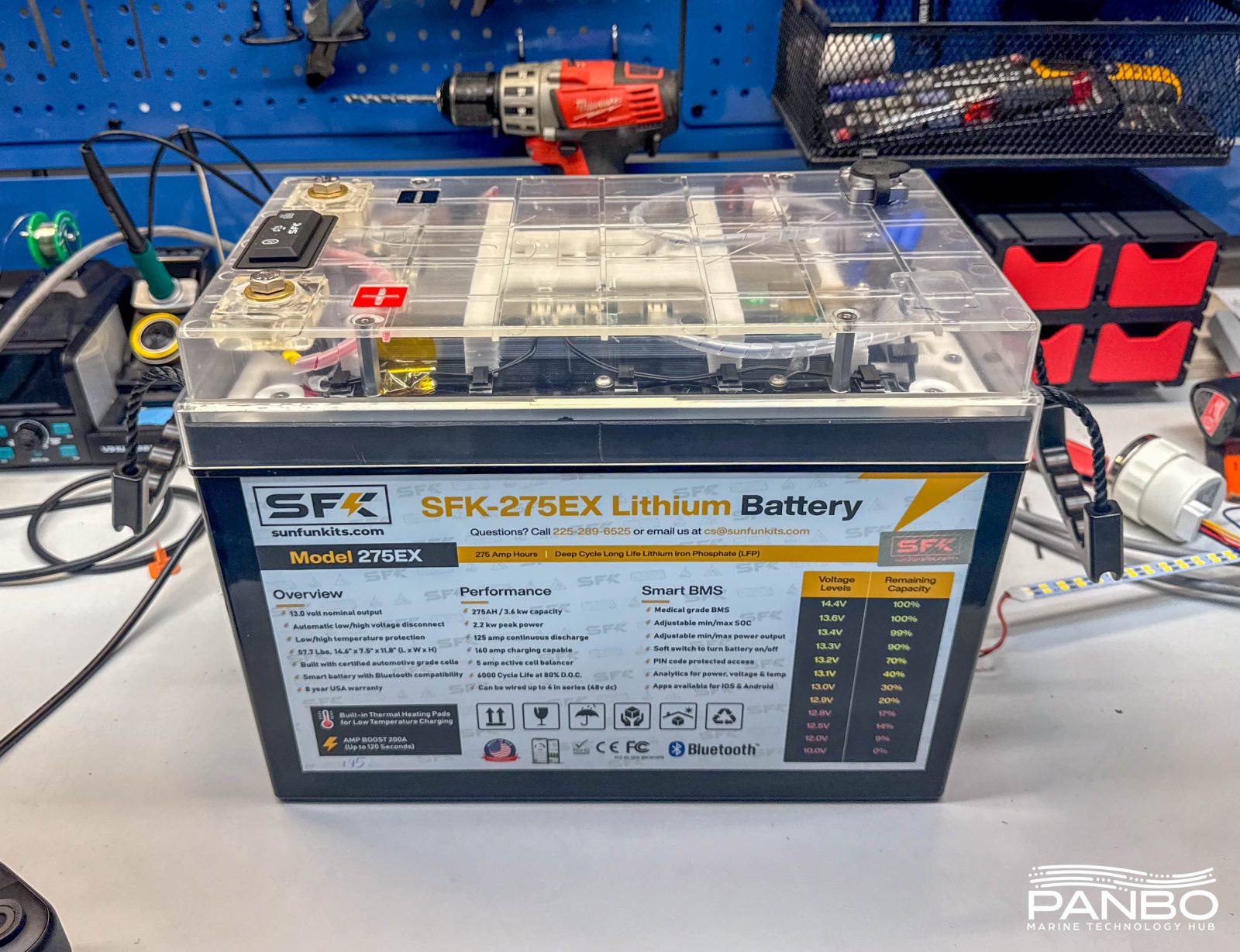
At first glance, the SFK 275EX looks like many other 275-300 amp hour internal BMS lithium iron phosphate batteries. With Bluetooth communications, heating, long cycle life, and a good warranty it seems to compete well with other batteries. But, closer inspection reveals a battery with features above and beyond anything I’ve seen in similar form-factor and priced batteries. Not only that, it comes with a thorough and readable manual.
SFK is short for Sun Fun Kits, a somewhat campy name I suspect the company might be de-emphasizing. But, campy or not, Sun Fun Kits tells the story of the company’s history. They started out selling kits and supplies for do-it-yourselfers to build their own LiFePO4 batteries. That heritage leads to a surprisingly transparent company. As you will see throughout this review, they are not shy about disclosing cell manufacturer and details, BMS information, nor test results from the construction of the battery. Heck, the company is so transparent they send out clear lid versions of the batteries for reviews (sorry).
Review batteries
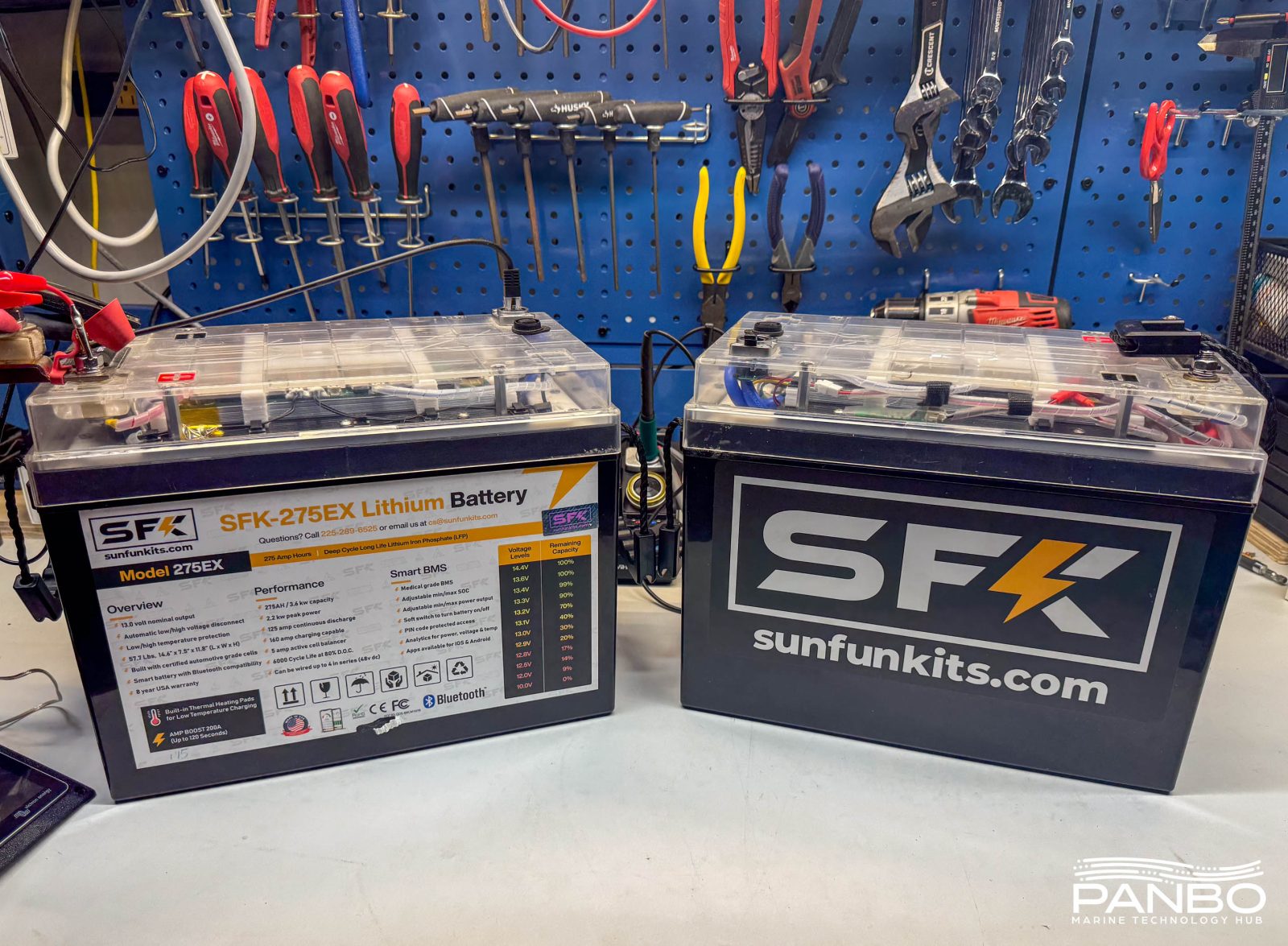
SFK provided me a pair of their 275 amp hour SFK-275EX 275 amp-hour 12-volt lithium iron phosphate batteries. These $1,115 batteries offer Bluetooth communications, heating, Victron communications (via a novel apporach, more on that later), active balancing, and more. These batteries are rated for 6,000 cycles at 80-percent depth-of-discharge and a lifespan of ten to fifteen years. With a rating of 6,000 cycles, I wouldn’t concern myself with cycles. Even over a fifteen year lifespan, that would be 400 cycles per year or more than one cycle per day.
As I mentioned in my recent lithium testing roundup, these are extremely compact batteries for their capacity. At 14.6 by 7.5 inches and 11.6 inches tall, these are roughly group 31 sized, though about two inches taller. The batteries come in under 60 pounds which makes them pretty friendly to haul around. In just over one and half square feet and 120 pounds, you can house 550 amp hours of batteries.
The 275EX is rated for 125 amps of continuous discharge current and up to 200 amps for 120 seconds of peak current. The maximum charge rate is 160 amps. Up to 5 amps of active balancing begins at 2.9 volts per cell or roughly 11.6 volts for the pack and ends at 3.6 volts per cell or 14.4 volts for the pack. Of all the batteries That’s a very wide range over which balancing occurs and at 5 amps I expect the BMS and balancer to have no trouble keeping the cells balanced.
The manual
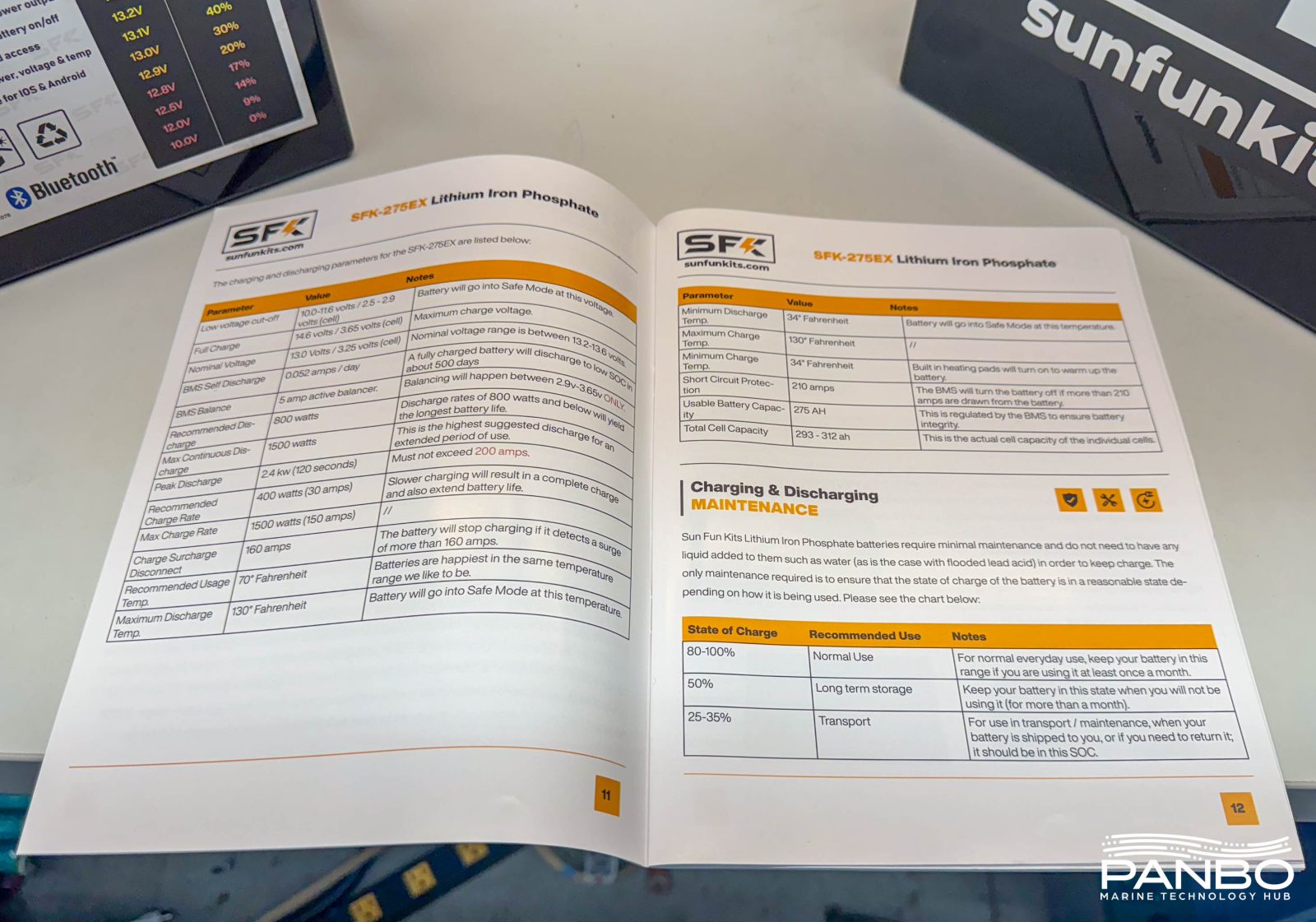
I don’t think I’ve ever written a battery review with its own section for the manual, but I also can’t remember being this impressed by a manual. I am fully aware that none of us buy a battery for its manual, but this one is really impressive. The 52 page manual clearly lays out all the information you need to install, wire, and operate the battery and its apps. The manual’s clear and easily understandable language makes it suitable for all users.
There is a lot of technical information in it, but that information is delivered without overwhelming the reader. If you think I’m a little silly to be so pleased with the manual, consider the number of batteries I’ve seen with little more than a pamphlet for a manual. As you will see throughout this review, SFK didn’t just pay attention to the battery, they also nail the details that help consumers use and understand their batteries.
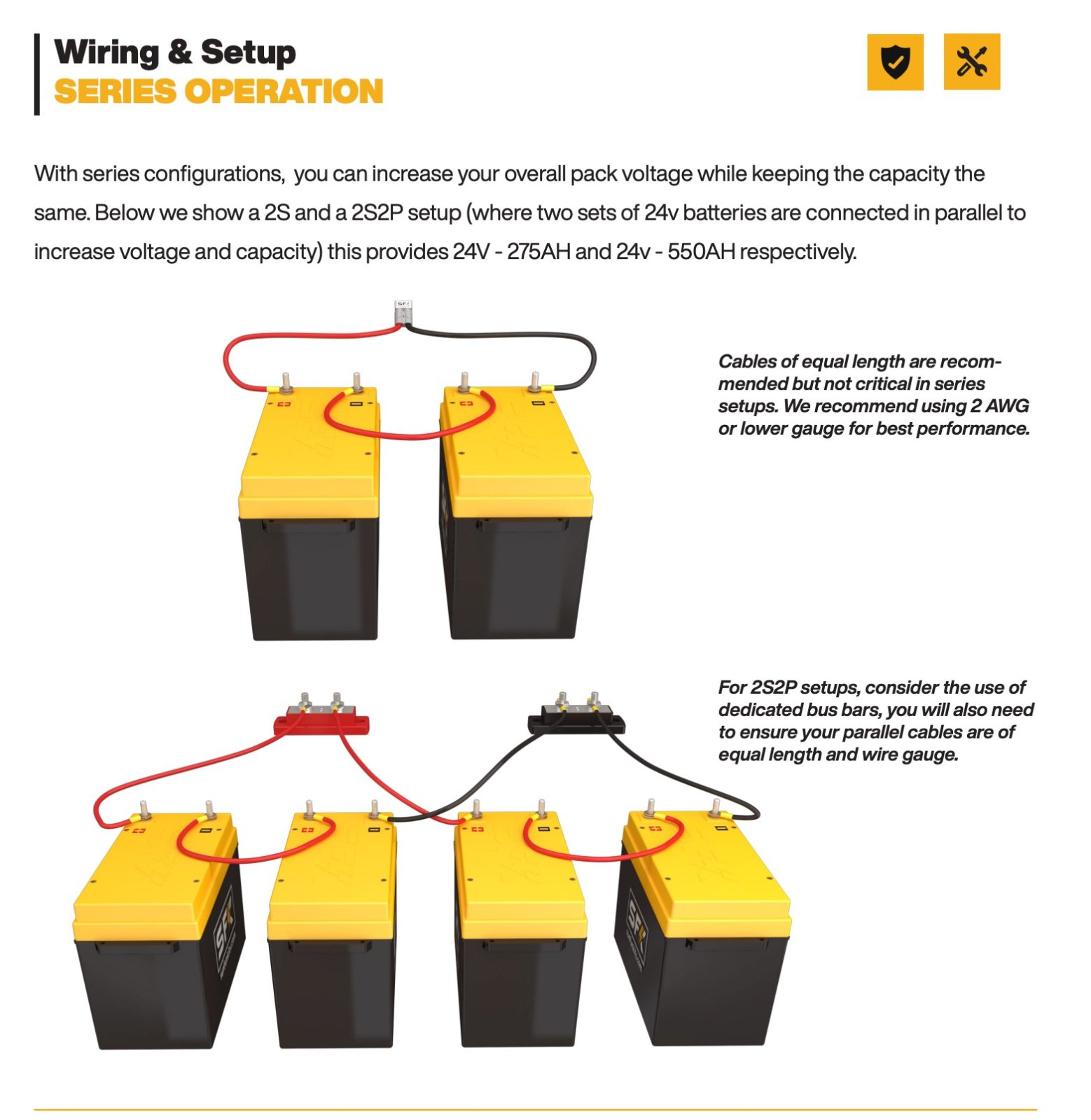
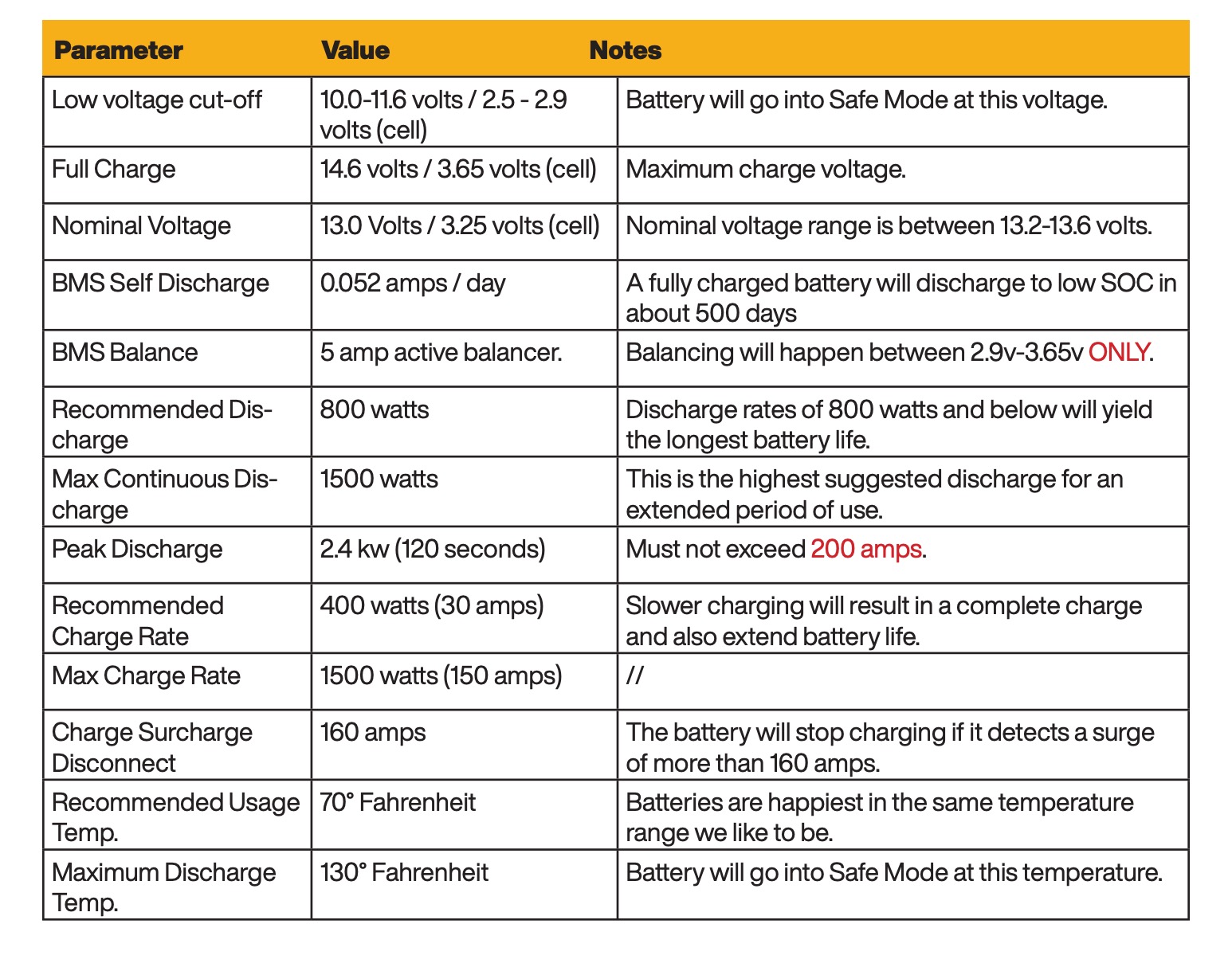
The manual contains useful and helpful drawings and diagrams for potential installation scenarios. Additionally, it documents the parameters, limits, and safety values the battery uses. This documentation helps a boater use the battery optimally and understand what happened when things go awry.
Testing and certification
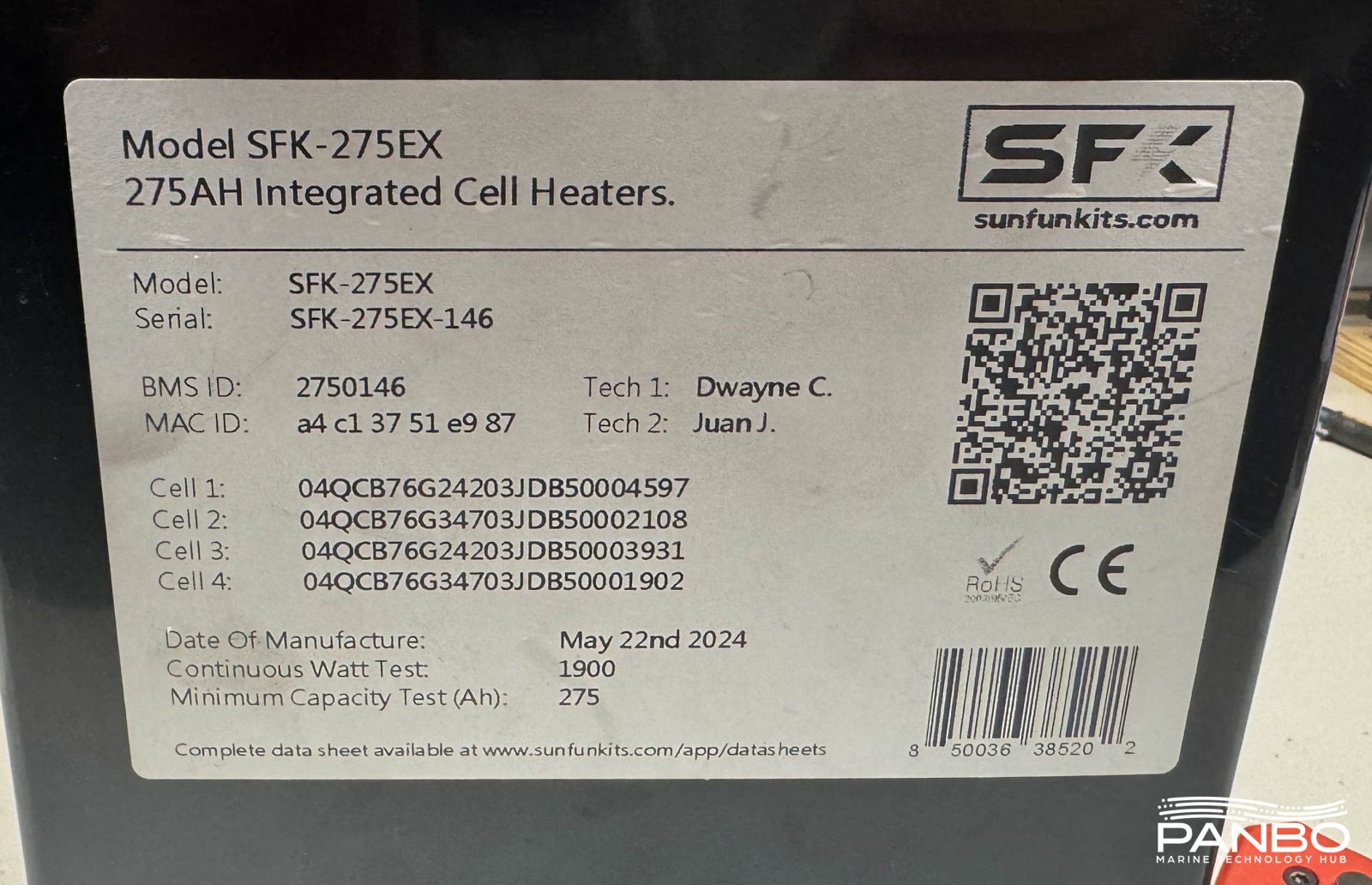
Each battery has a data sticker on its side. That sticker shows the construction details for the battery including the BMS and cell ID information. Most importantly, the QR code towards the top right of the sticker takes you to SFK’s Serial Check functionality on their website.
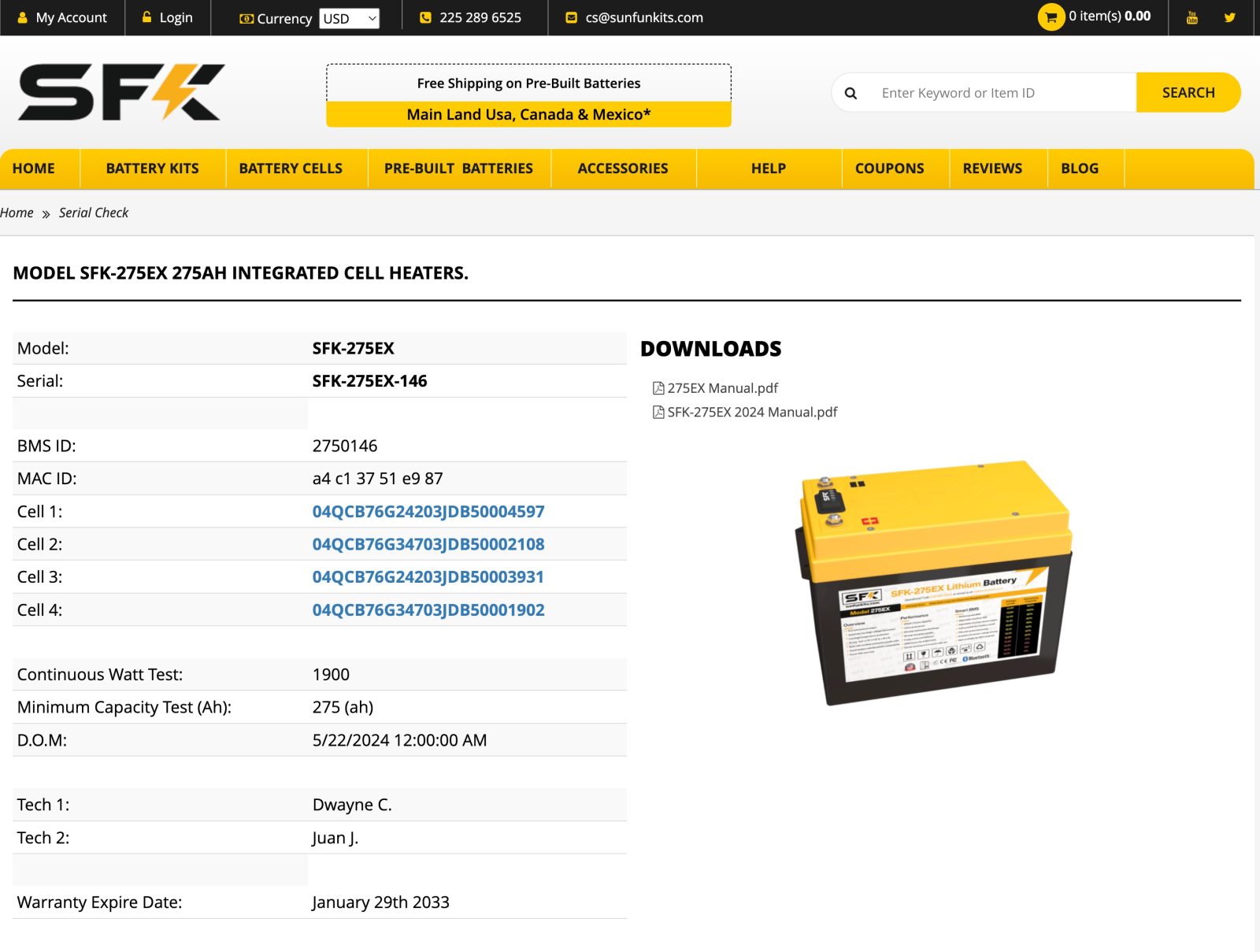
The information on the website is largely a repeat of what you find on the sticker with the benefit of links to the battery’s manual and, most importantly, clickable links for each of the four cells in the battery. Clicking these links brings you to cell details for each of the four cells.
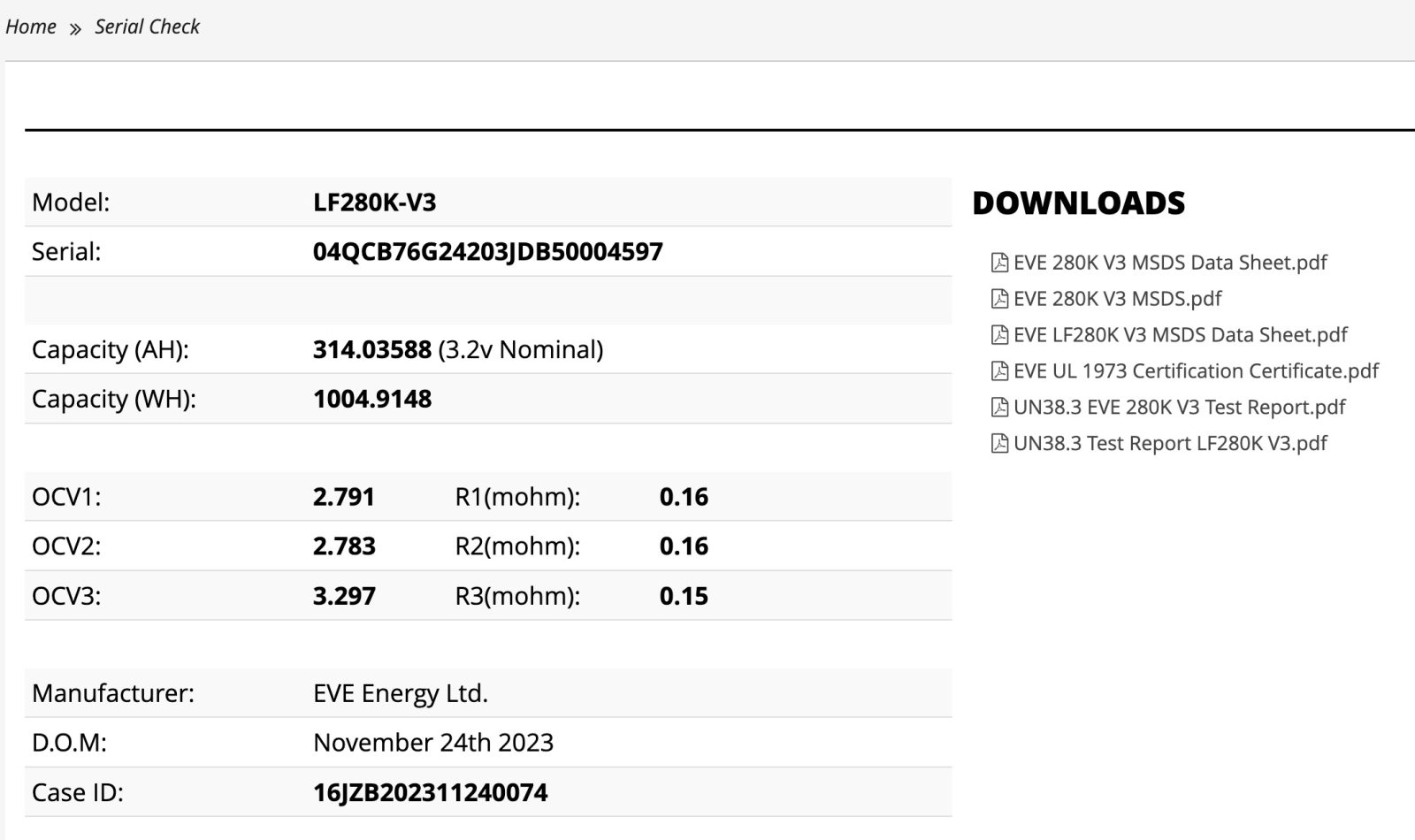
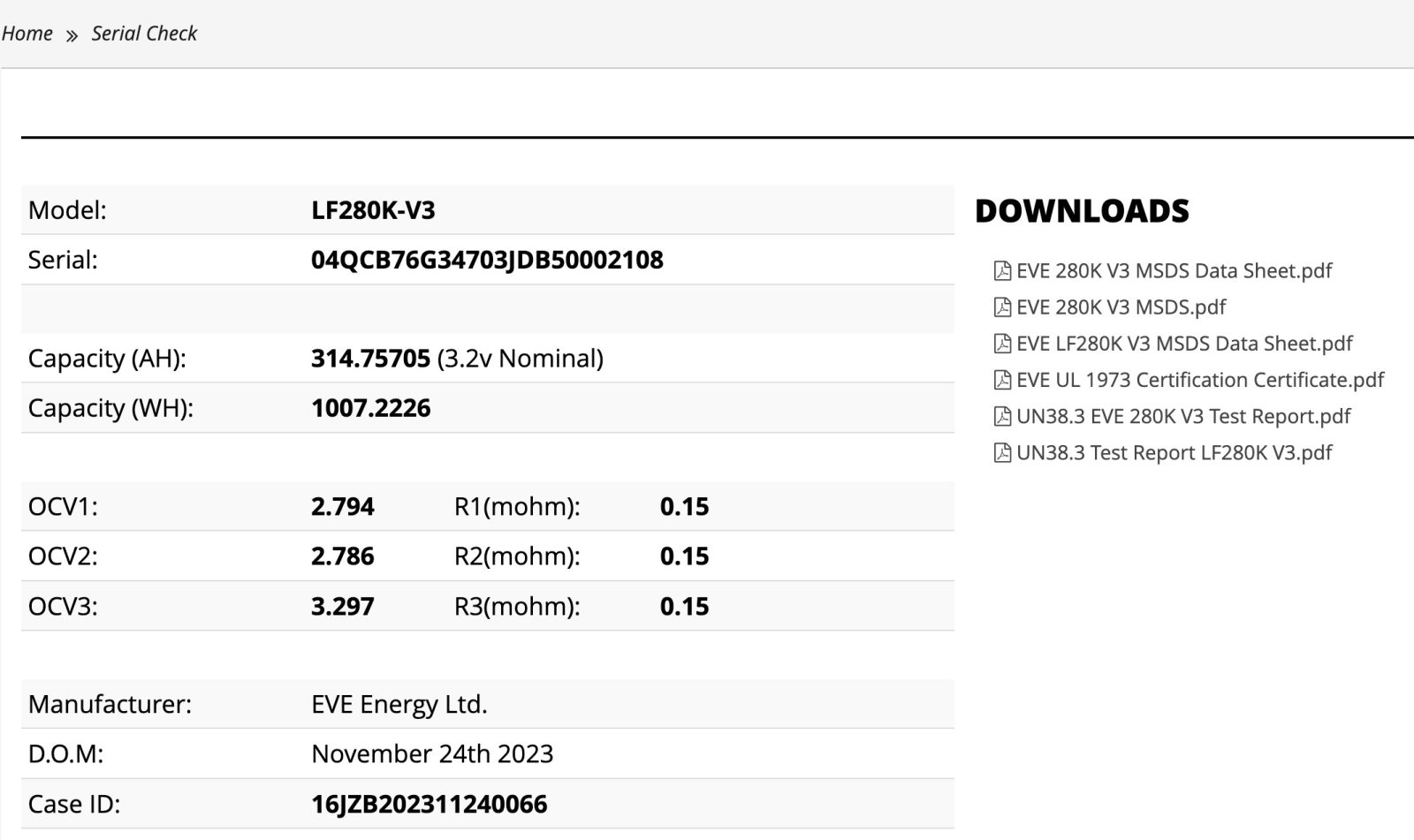
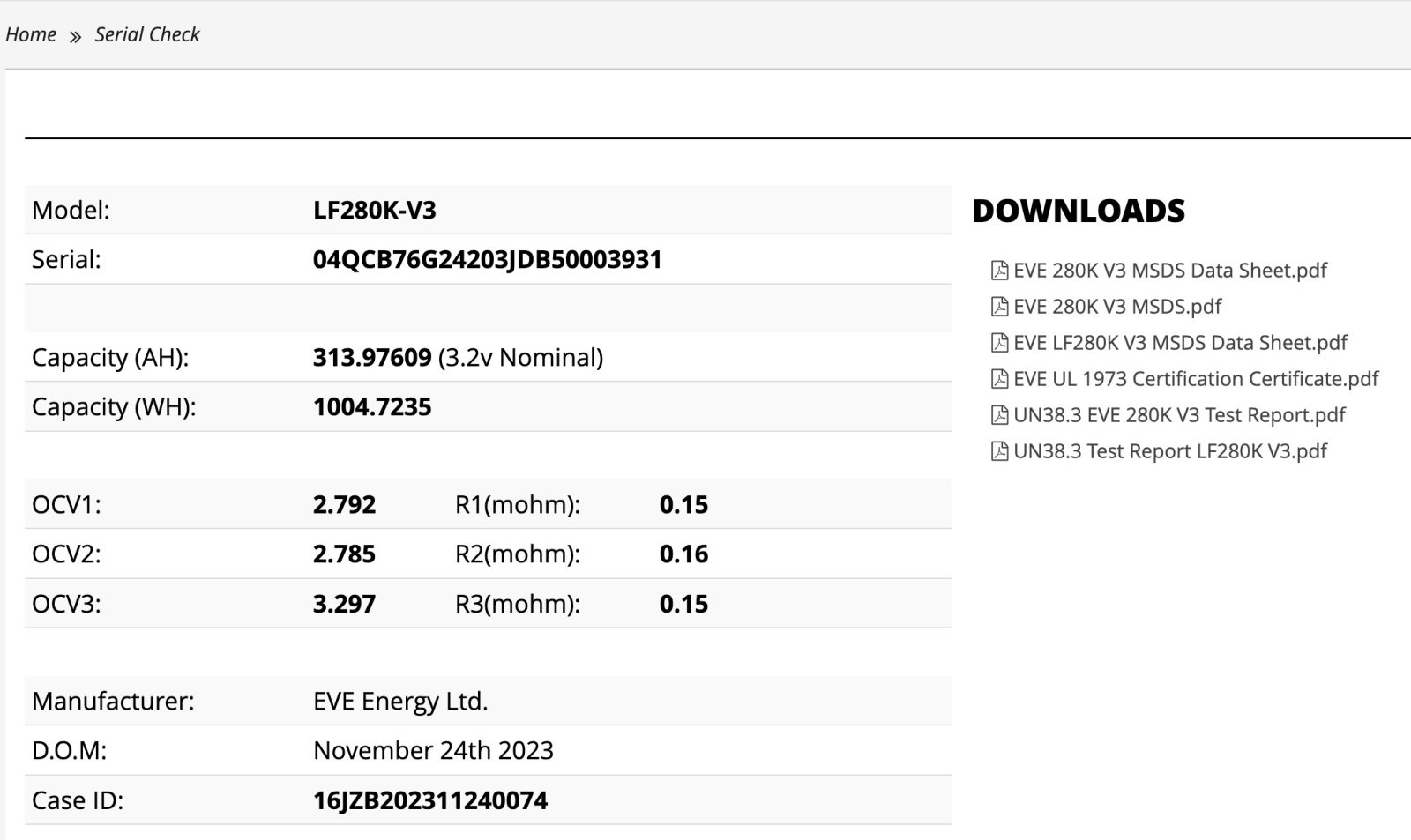
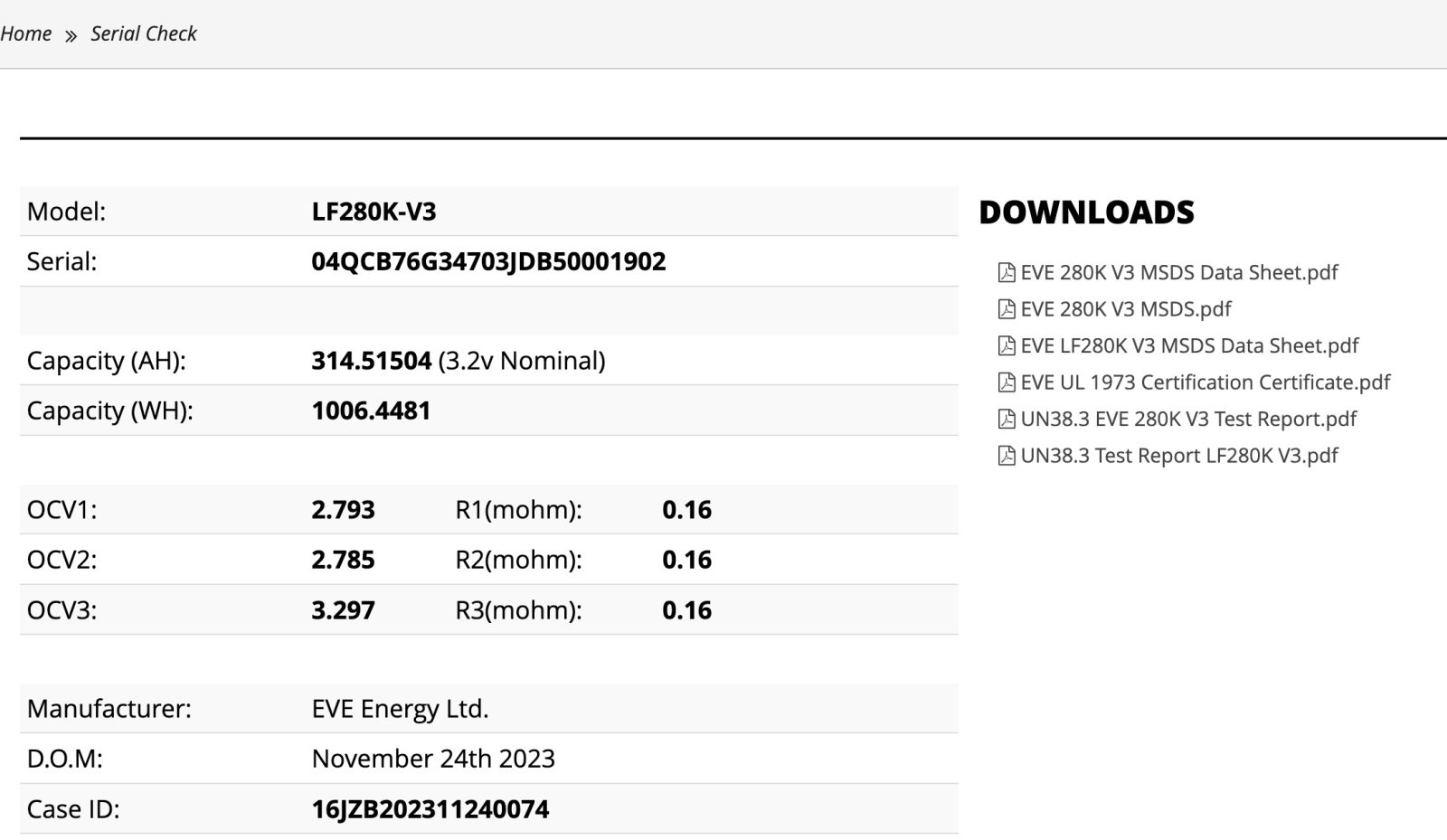
Cell details shows several interesting details including both amp hour and watt hour capacity tests, internal resistance, cell manufacturer and date of manufacture. I want to call out that these are 280 amp hour cells that SFK sells as a 275 amp hour battery. This, despite the fact their own testing shows the lowest capacity cell tested to 313.976 amp hours. They could easily sell these batteries as 300 amp hours and have the capacity tests to prove it.
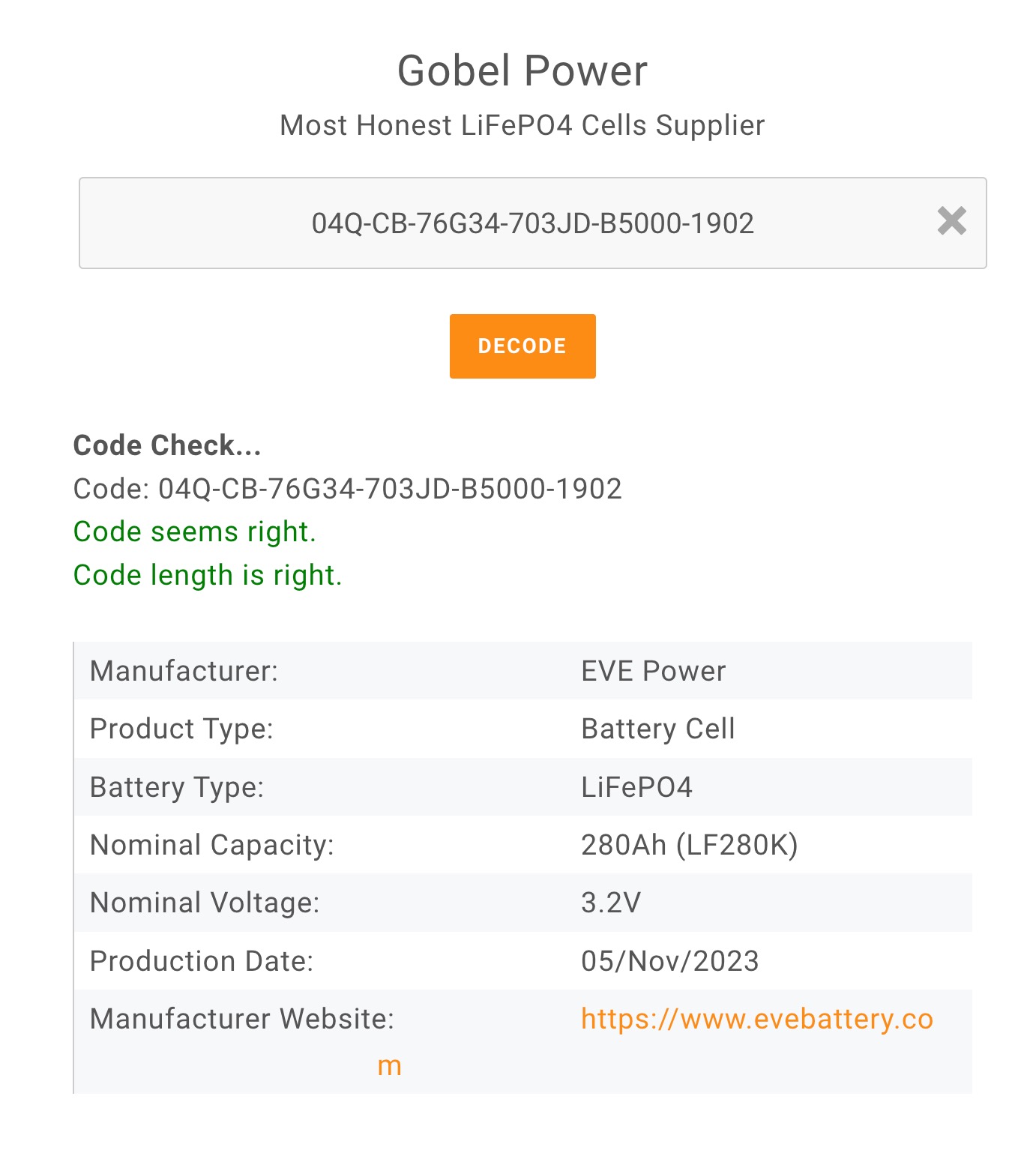
The cell serial number shown on each cell detail report can be pasted right into any LiFePO4 QR code decoder. Above, I used Gobel Power’s decoder to confirm what’s shown in the report.
Real world testing
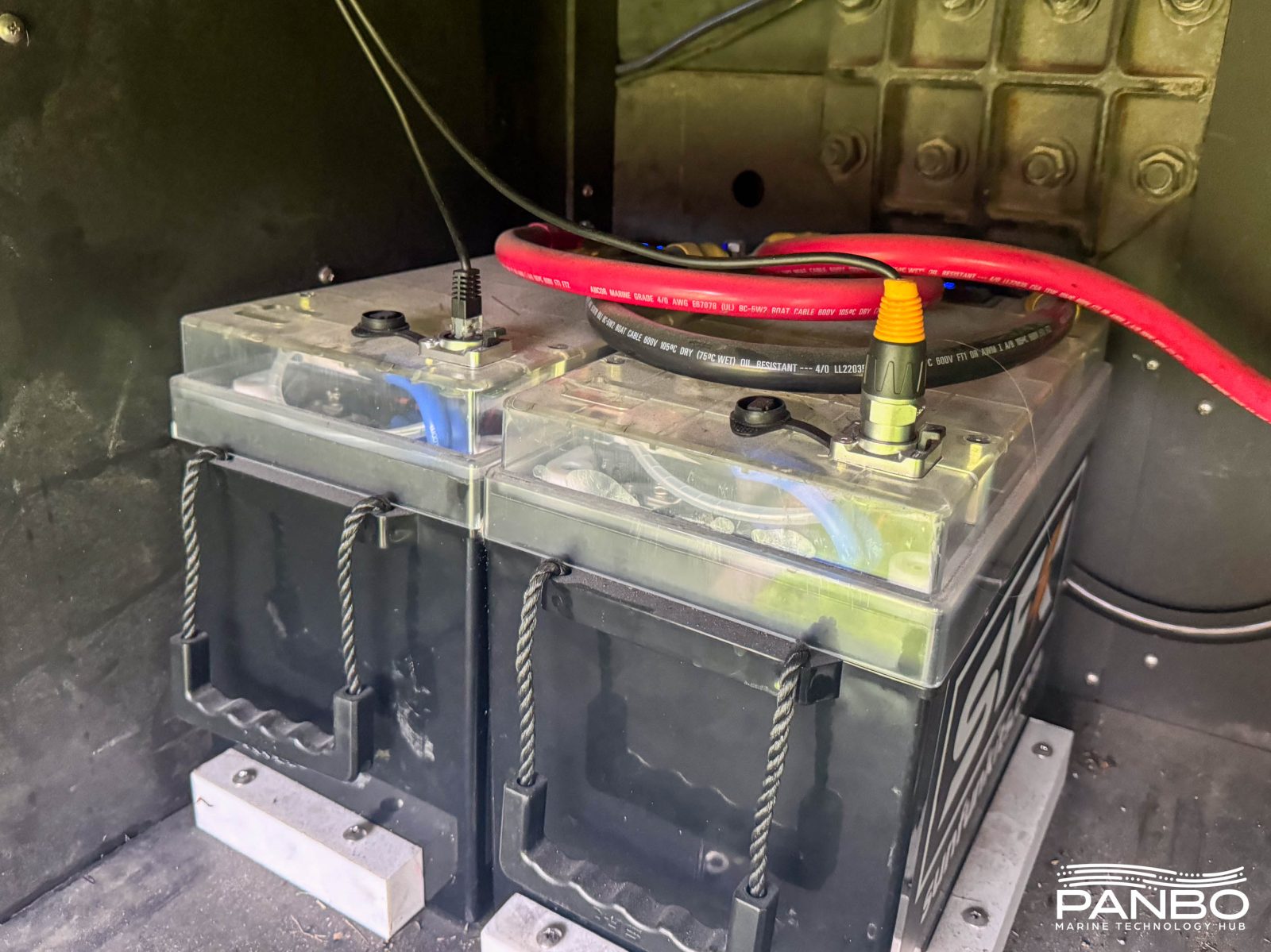
Over the summer, my family and I spent about ten weeks living in our RV. That time presented a golden opportunity to put the SFKs to the test and experience life with them. Frankly, despite pushing them pretty hard, including running one (woefully inefficient) 15,000 BTU rooftop air conditioning units, the testing was pretty boring. As you might expect for modern LiFePO4 batteries, they just did their job with no drama.
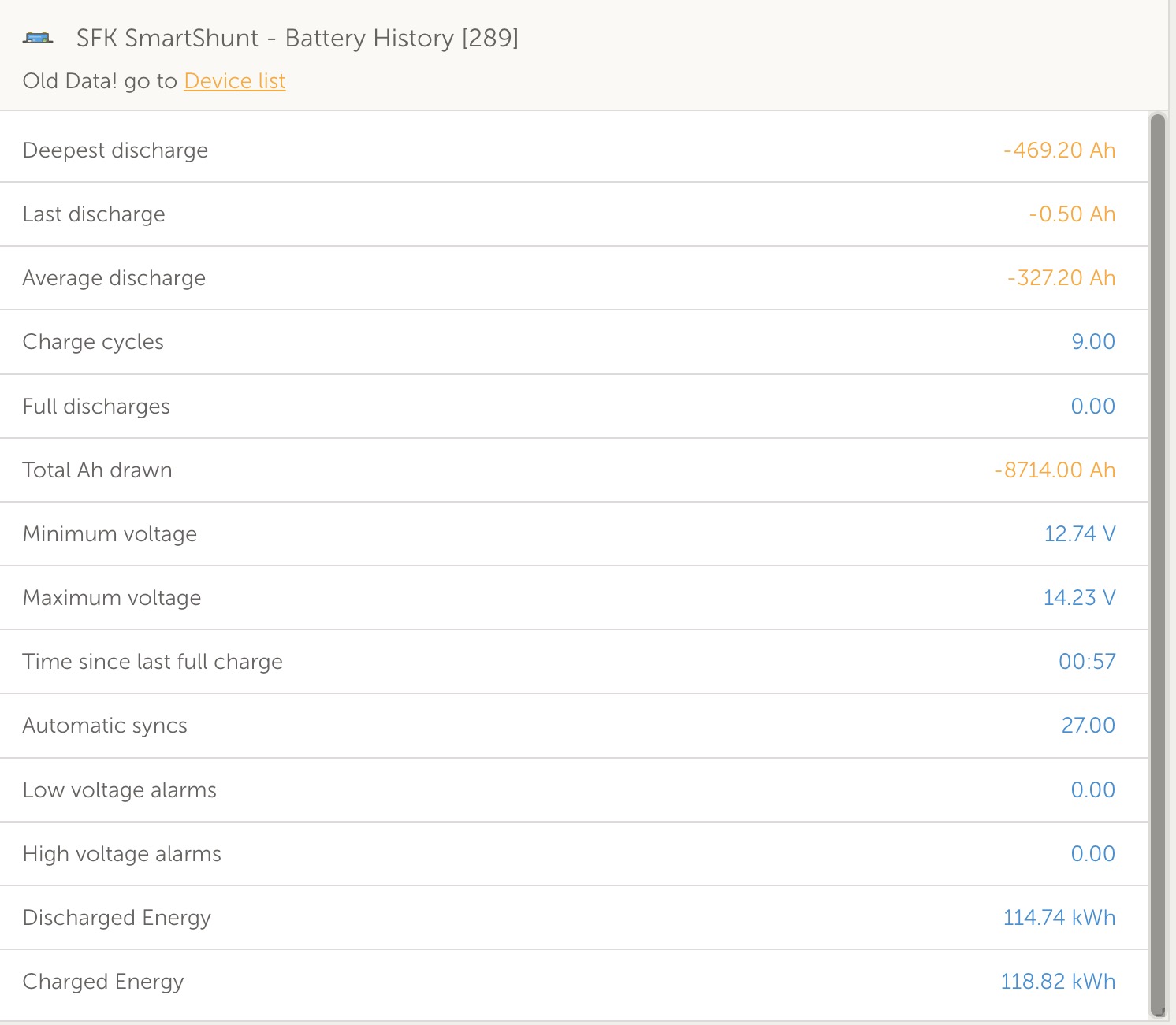
The history above shows the last four or so weeks of our trip. Unfortunately, in a low blood sugar, fat-fingered moment, I reset the history on the SmartShunt I was using and wiped the early results. But, as you can see for the lack of alarms, minimum voltage of 12.74 and maximum of 14.23, everything worked as it should. In total, I consumed and charged over 250 kilowatts of power through the batteries without a hiccup.
Bench testing
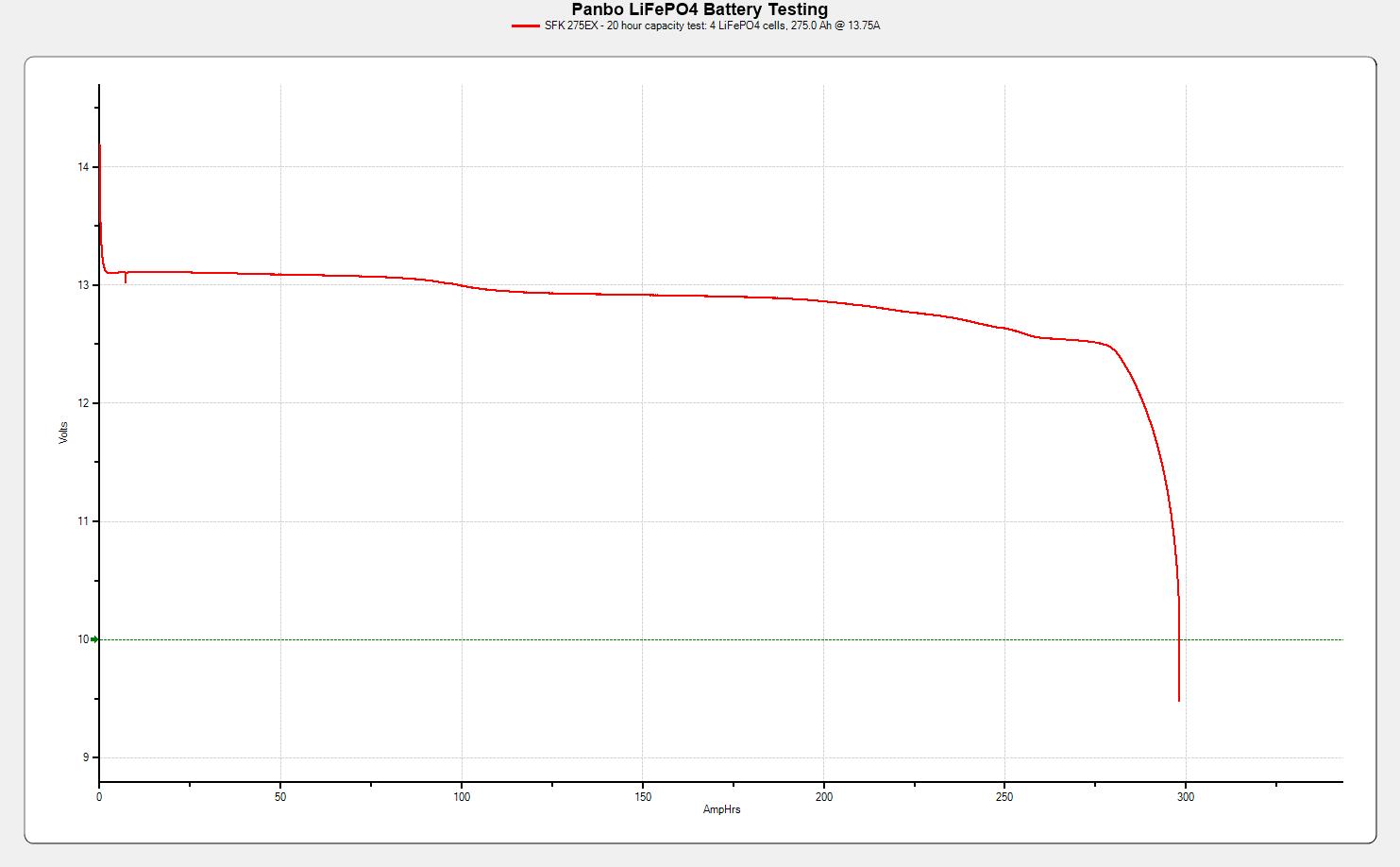
First things first, these batteries may be rated at 275 amp hours, but my early tests showed well over 300 ah capacity. Unfortunately, due to some technical difficulties in the capacity testing department, I’m still waiting on a final run after putting these batteries to work. I should that available tomorrow and will update. Now that the batteries have been through quite a few cycles, they are testing right at 300 amp hours. Still pretty impressive for a battery rated for 275. I’m not complaining about the capacity, however when setting up the SmartShunt I put in front of them, I debated long and hard over settings. Eventually, I decided on 300 amp hours per battery.
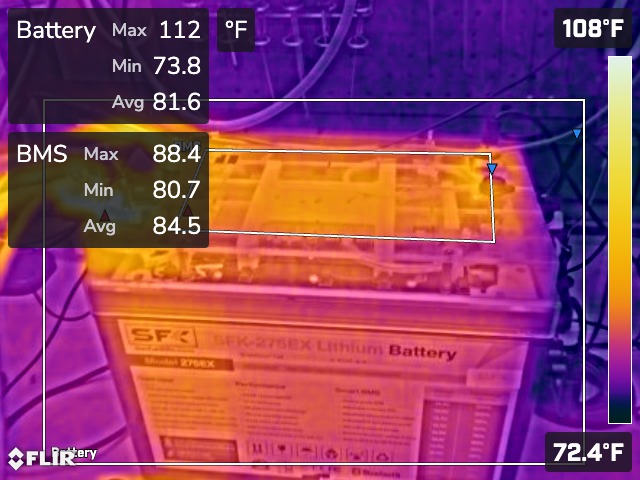
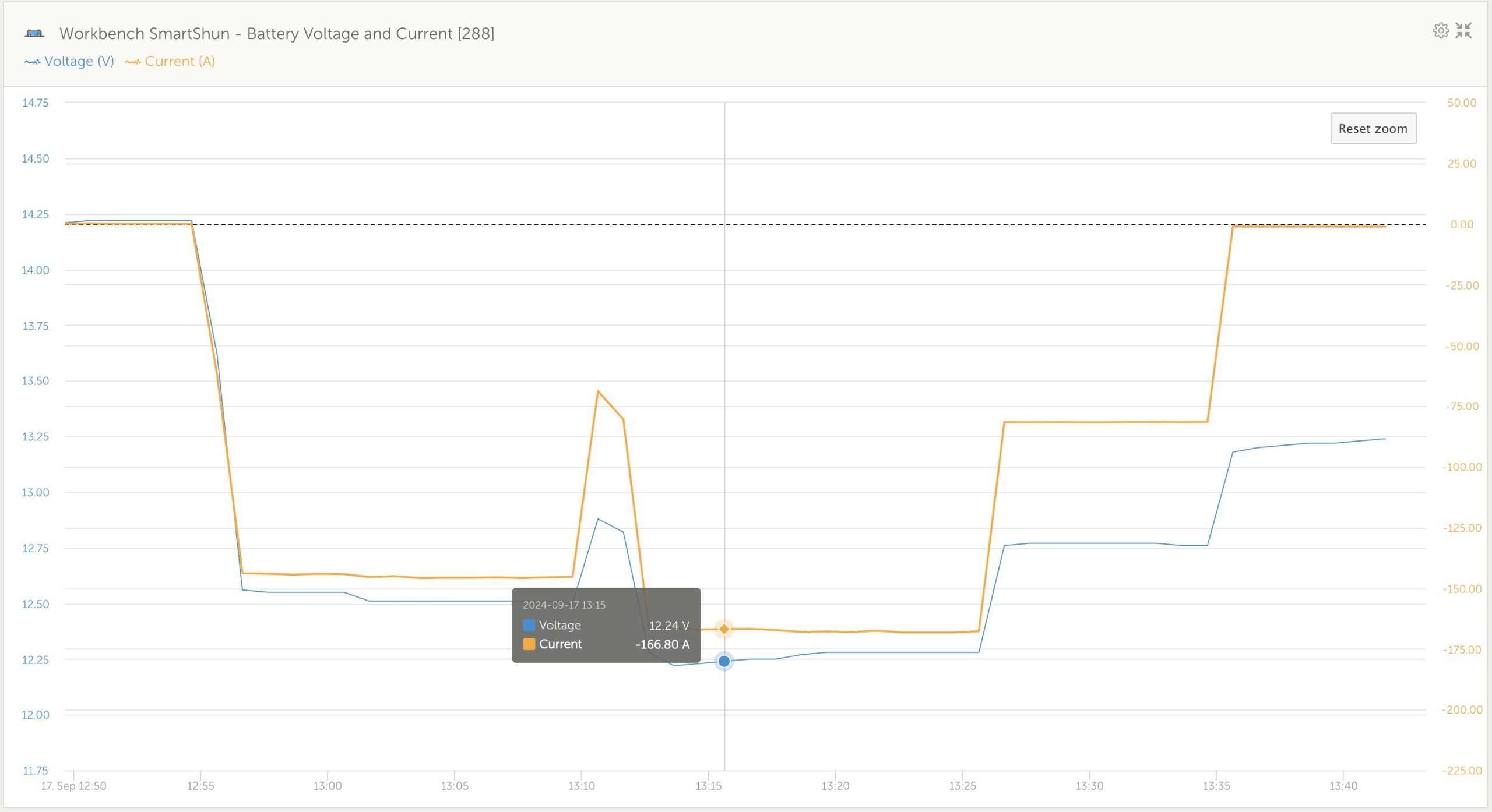
Subjecting one of the batteries to high current charge and discharge testing revealed nothing unusual. In fact, thermal testing of the batteries showed minimal temperature elevation, even under sustained 145-165 amp loads. Over the course of 30 minutes with a load averaging 140 amps, I sawtemperatures I would expect. The case of the battery barely increased over the ambient temperature. The case above the BMS saw temperatures climb about 3-4 degrees F while the terminals, especially positive with an MRBF in place, increased about 40 degrees above ambient.
SFK App
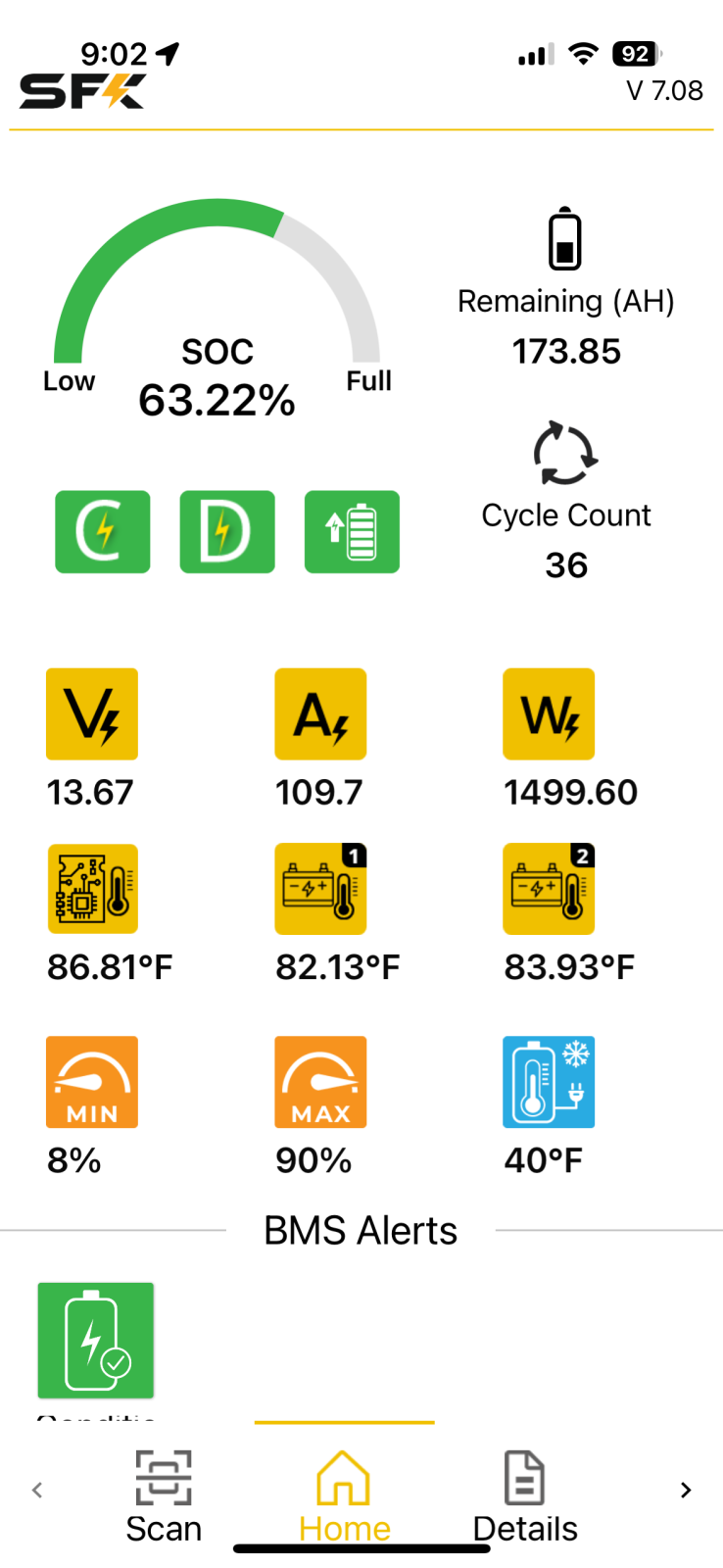
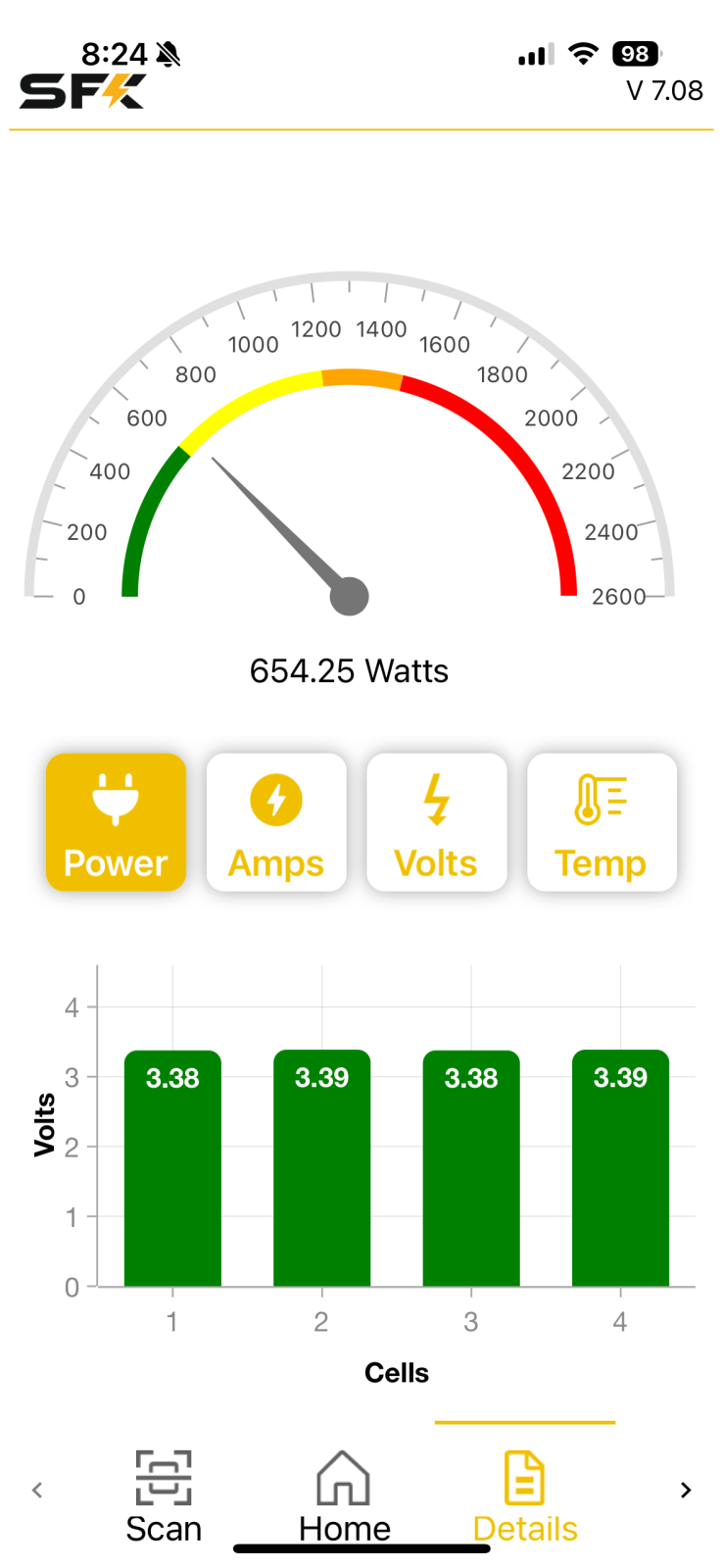
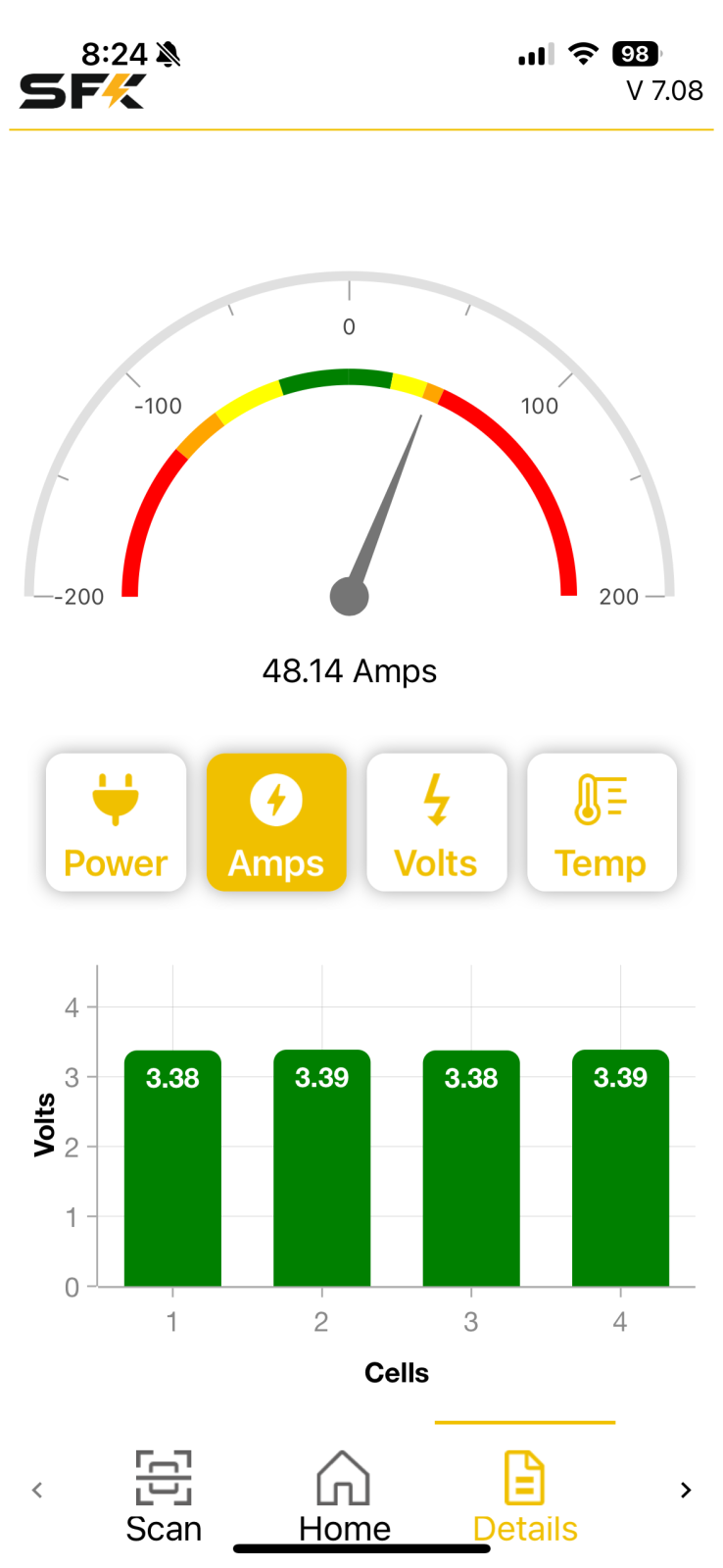
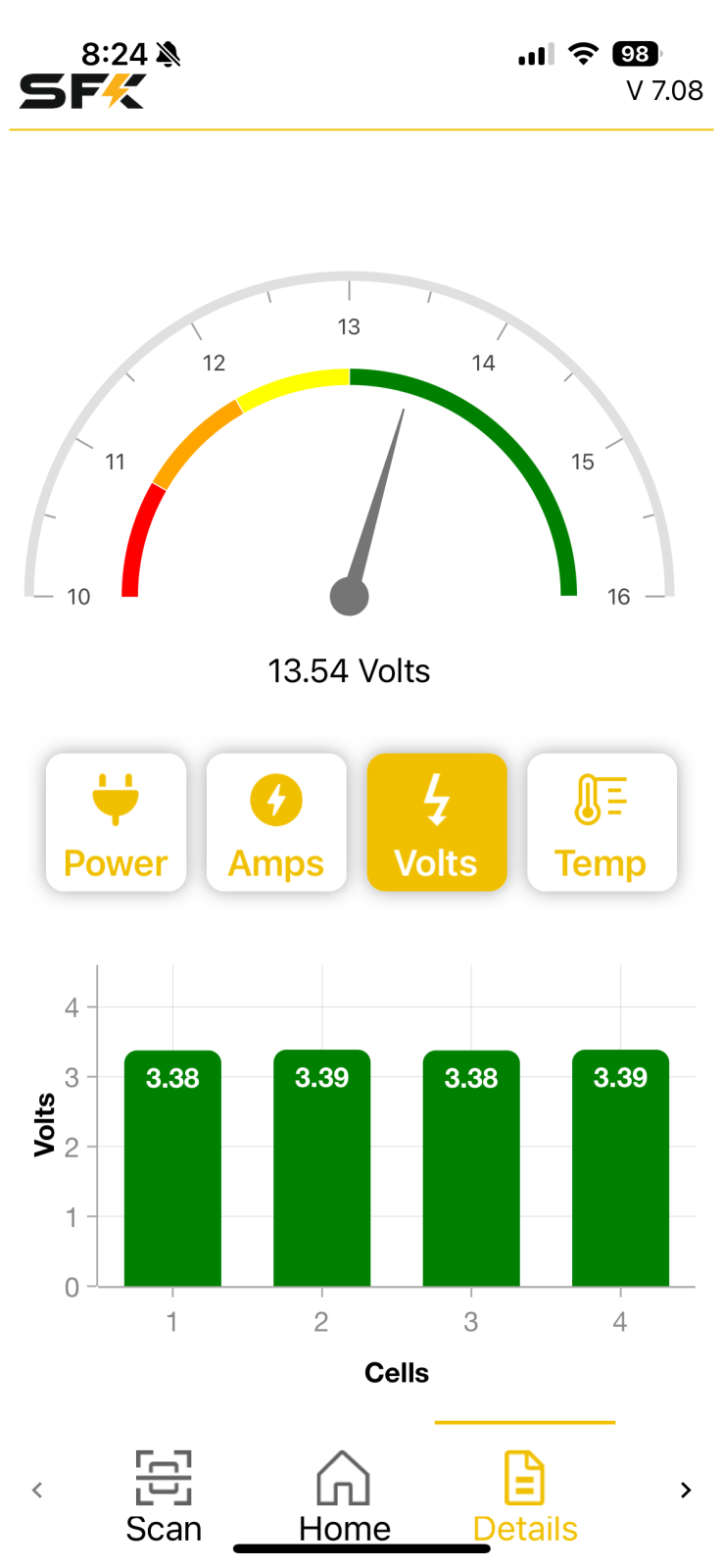
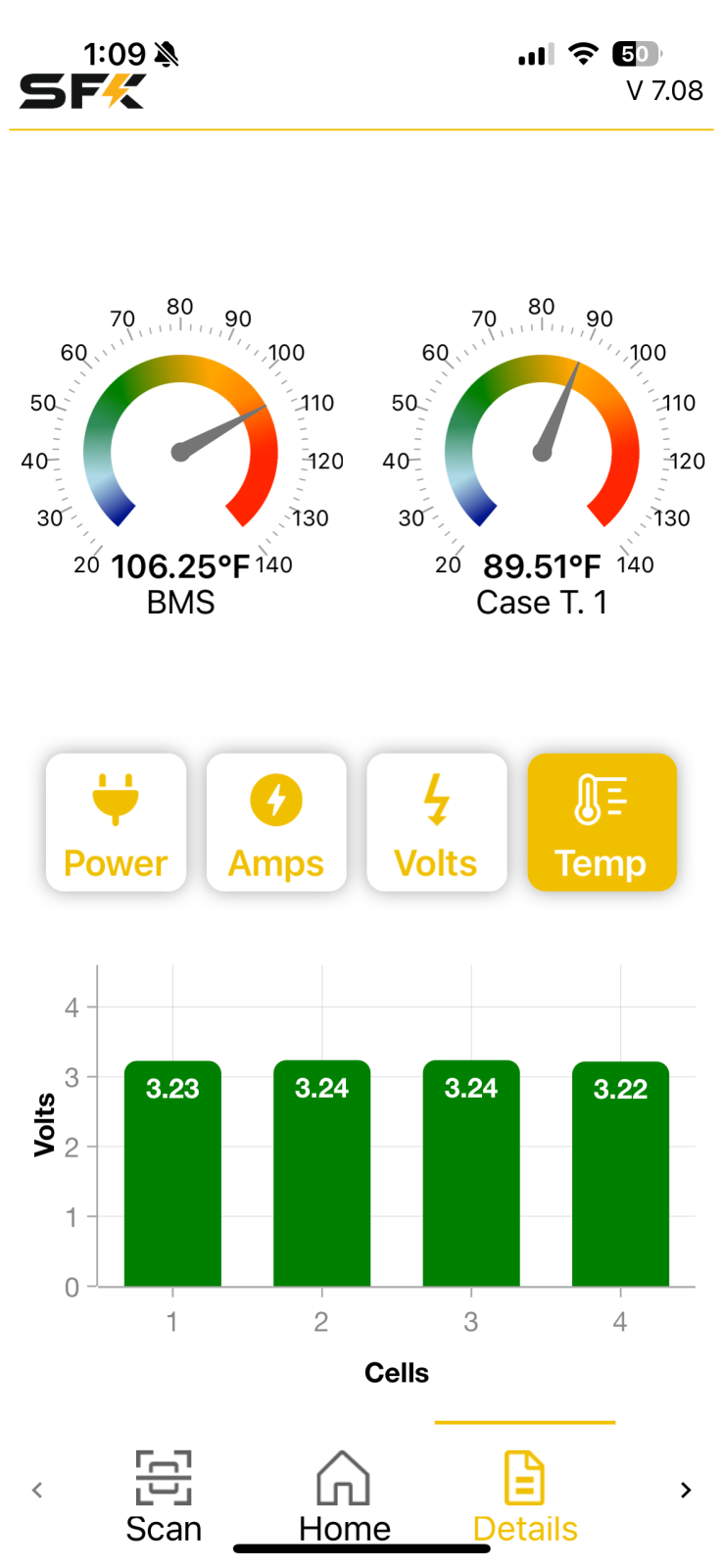
SFK’s app is among the best battery companion apps I’ve used. The app enables detailed monitoring of battery operations as well as extensive battery configuration. The screenshots above show first the basic battery operating information followed by the Details section displaying power, amp flow, voltage, and temperature readings. Each of the detail screens also show individual cell voltages.
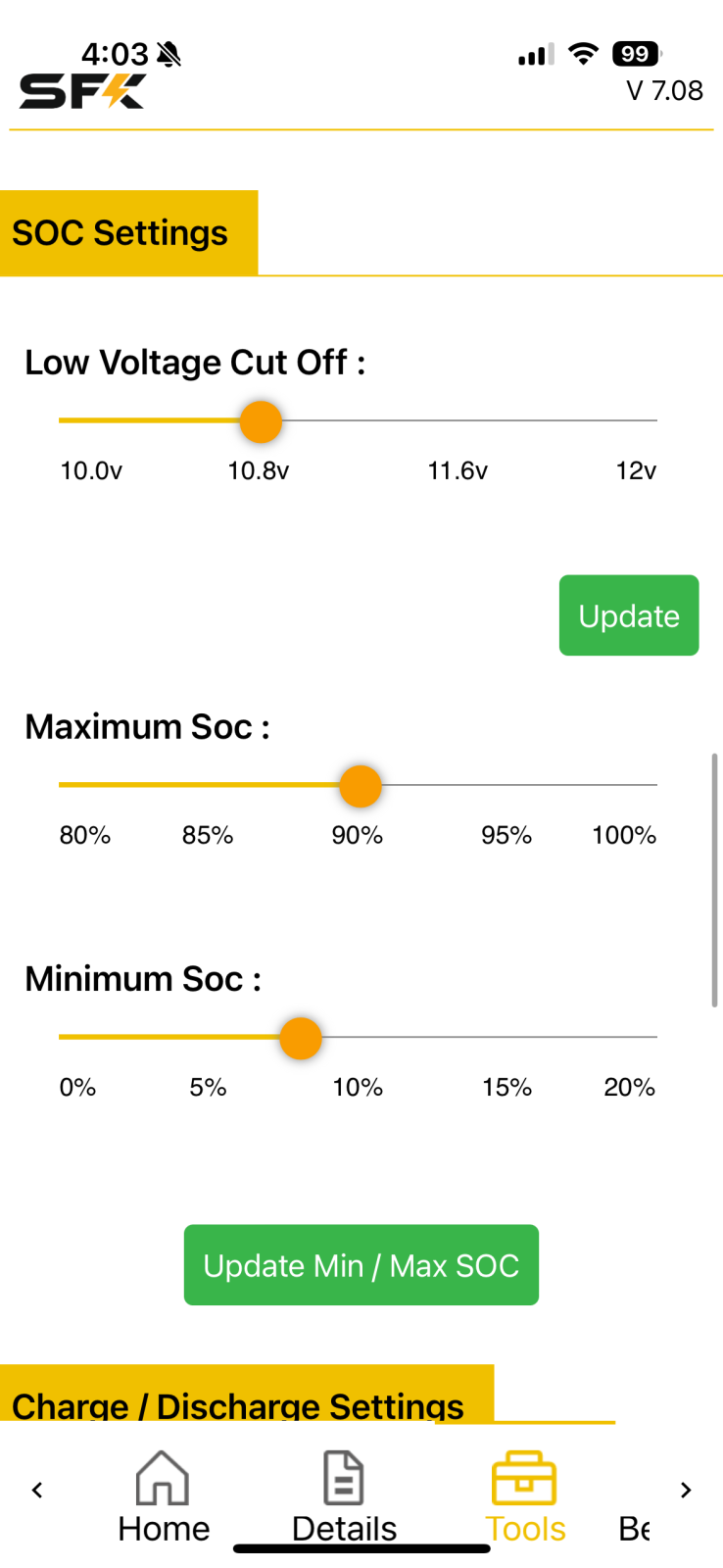
Adjustable low voltage cutoff and settable maximum and minimum SOC
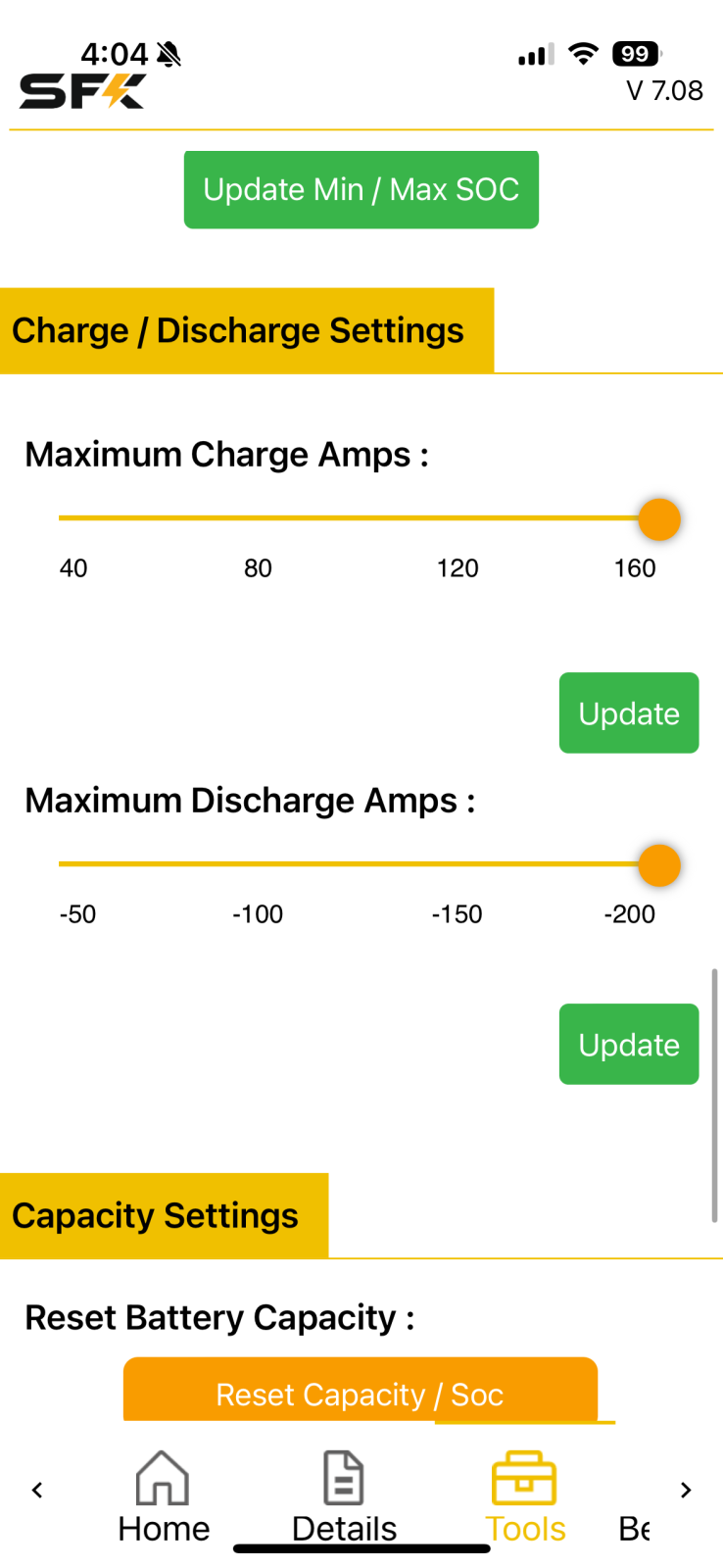
The app allows the user to set the low voltage protection threshold as well as adjusting SOC limits and amperage limits. If the low SOC limit is reached, the battery will shutdown discharge to protect and prolong the life of the battery. If the high SOC limit is reached, the battery will taper charge acceptance zero. That taper is designed to avoid a load dump for the charge source, but SFK says a user shouldn’t rely on that taper because of limited capacitance for the taper. In essence, if Victron communications or other means of limiting charge SOC are available, they should be used. Additionally, both charge and discharge current limits are adjustable. The maximum charge amperage is enforced the same way as maximum SOC, so the same caveats apply.
Virtual batteries
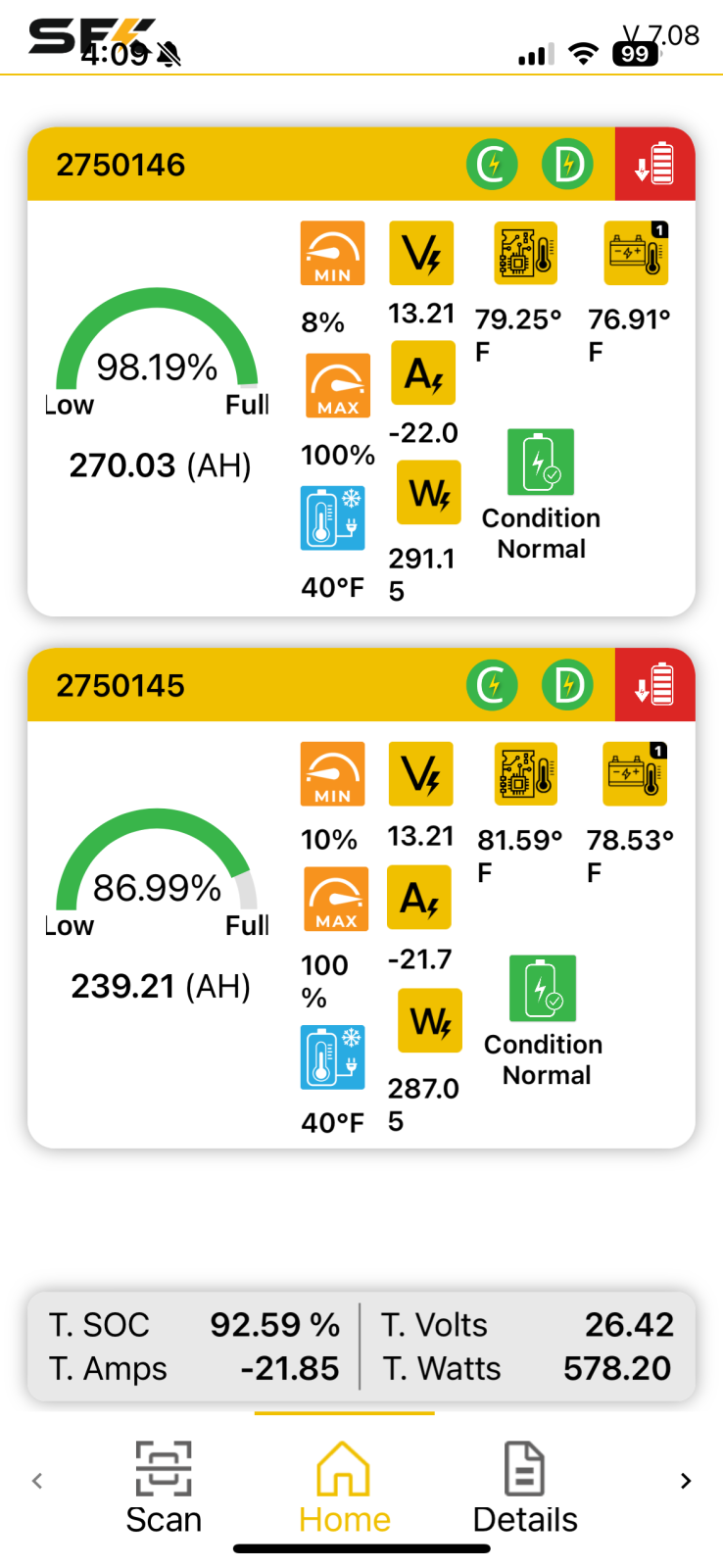
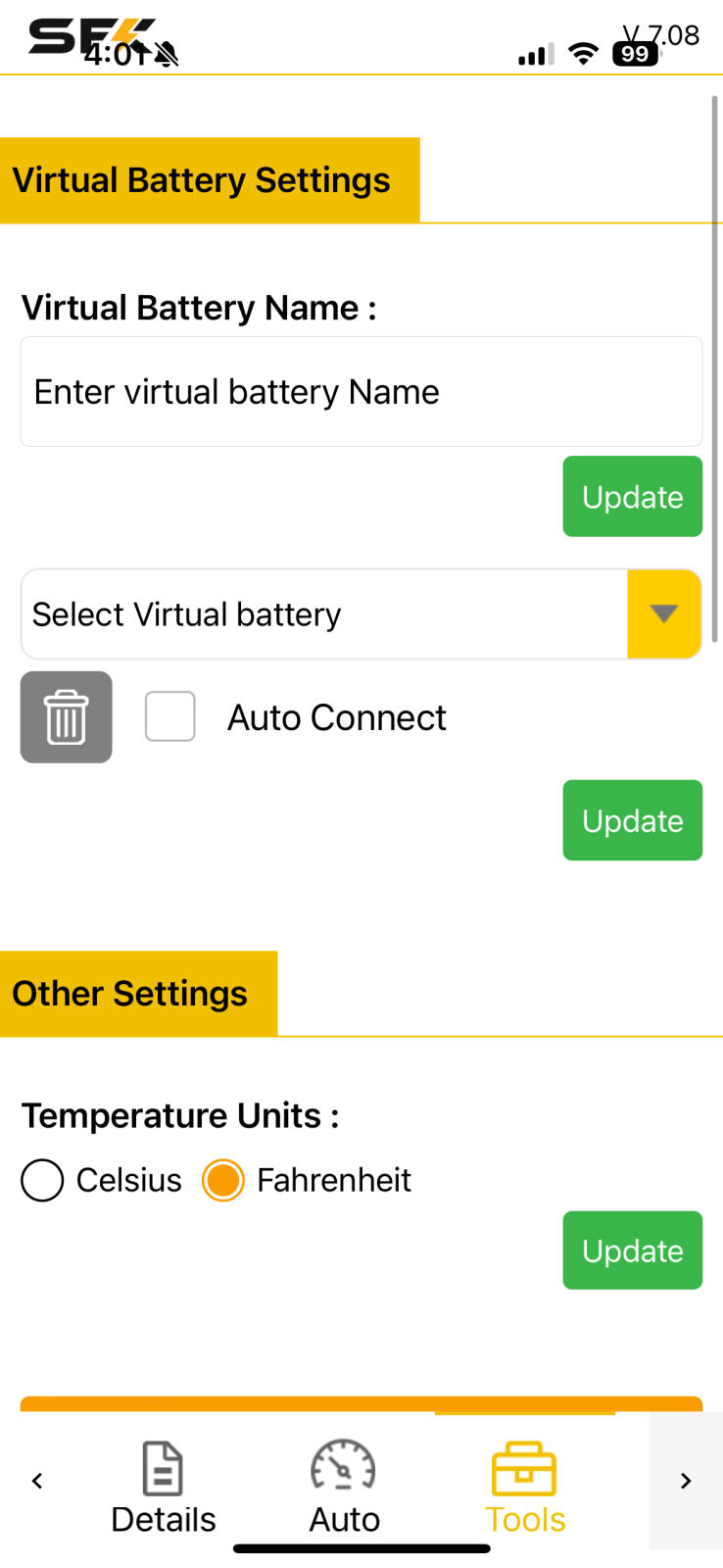
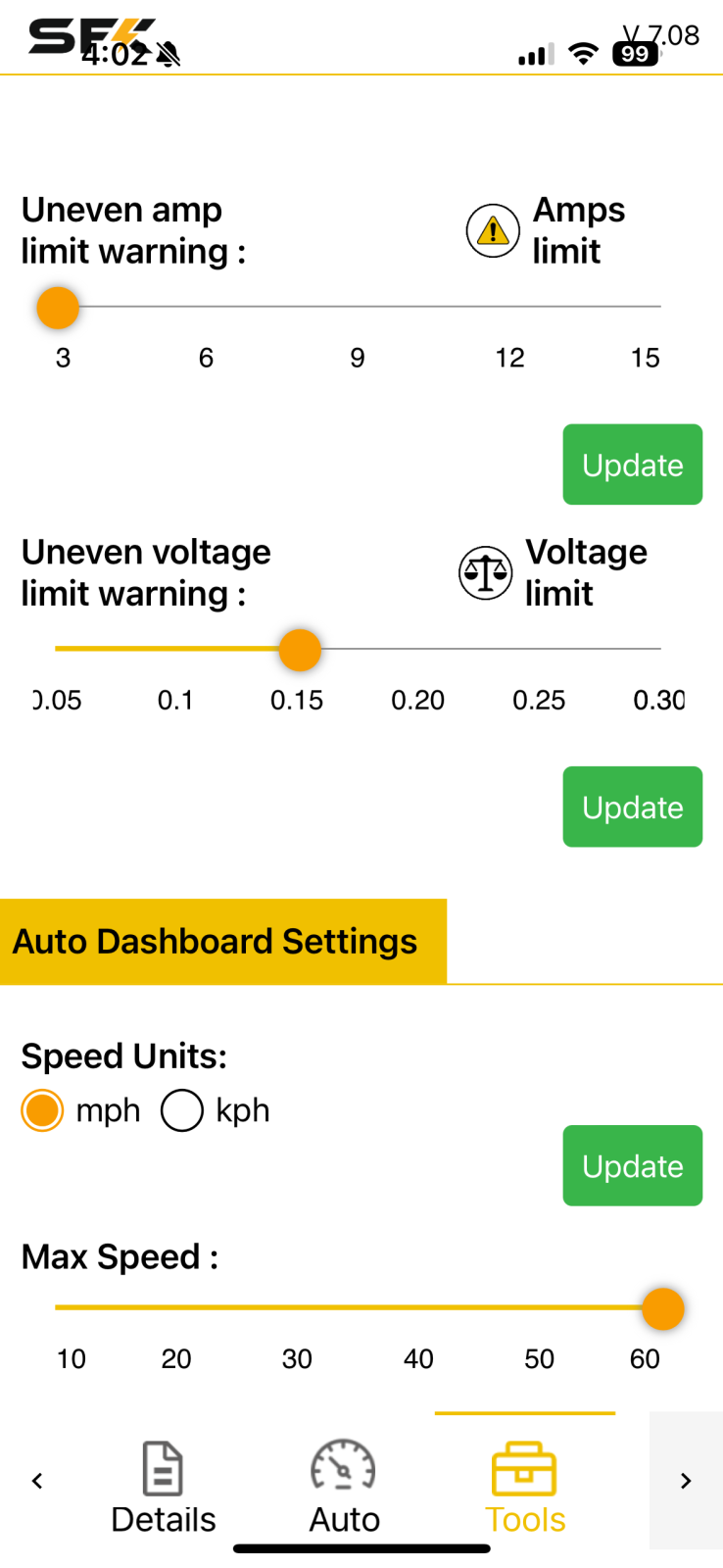
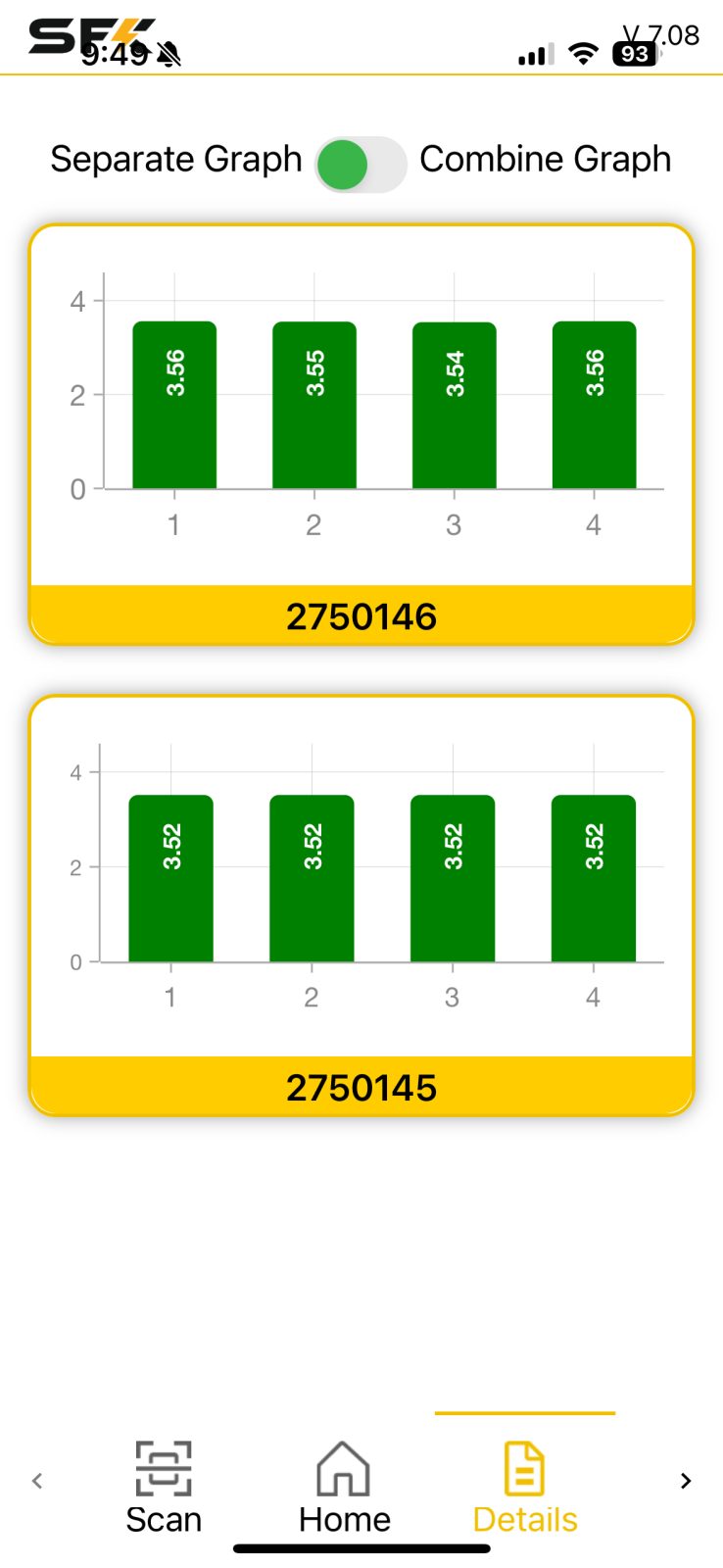
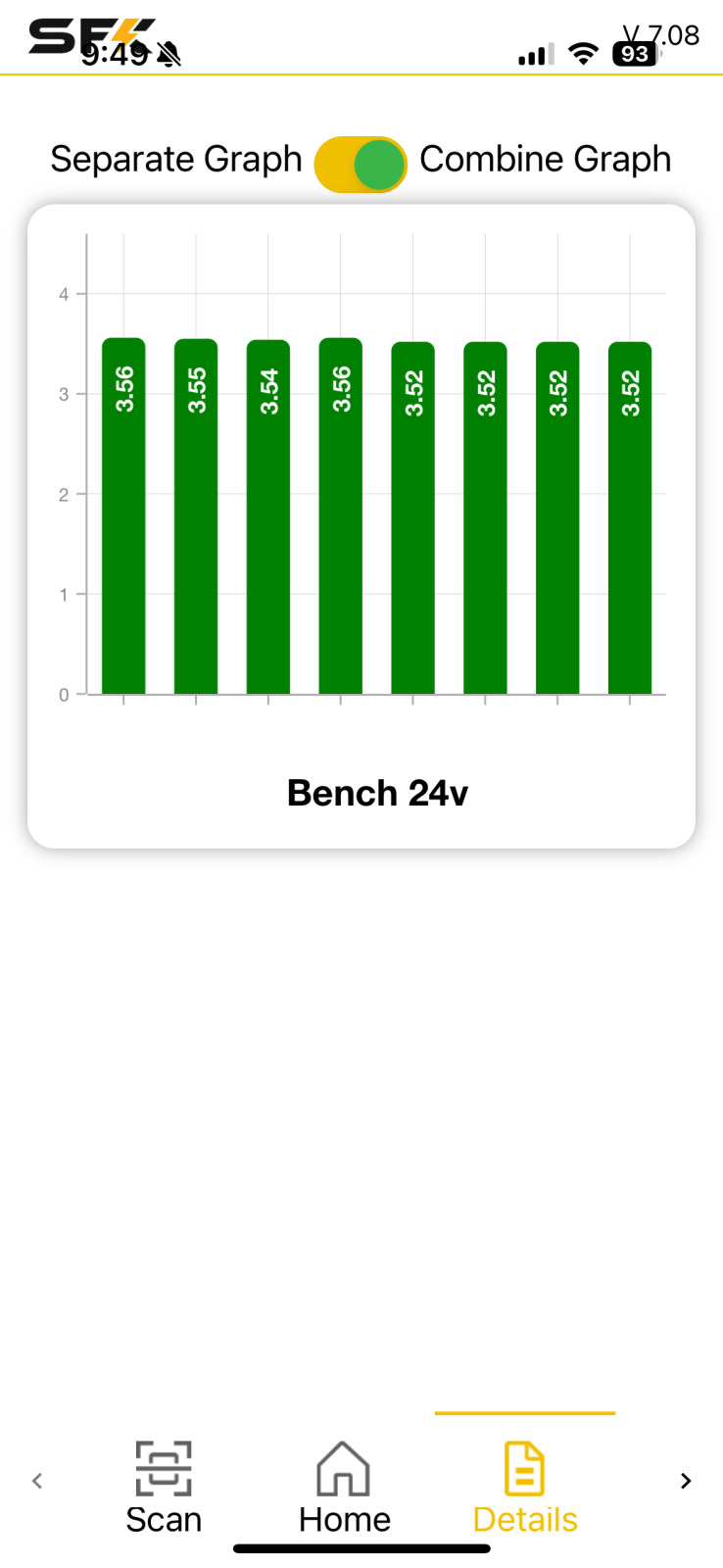
For multiple battery installations –and it seems likely most installations will include multiple batteries– virtual batteries can be created in the app. The virtual battery construct provides a few benefits: First, the summary screen displays all the batteries in a single screen and the Details screen shows cell voltages. Second, as shown in the third screenshot above, alerts can be configured for uneven amp draw as well as uneven voltage. These two alerts will notify you of wiring or balance issues with the batteries both in parallel and series.
Benchmark – capacity testing
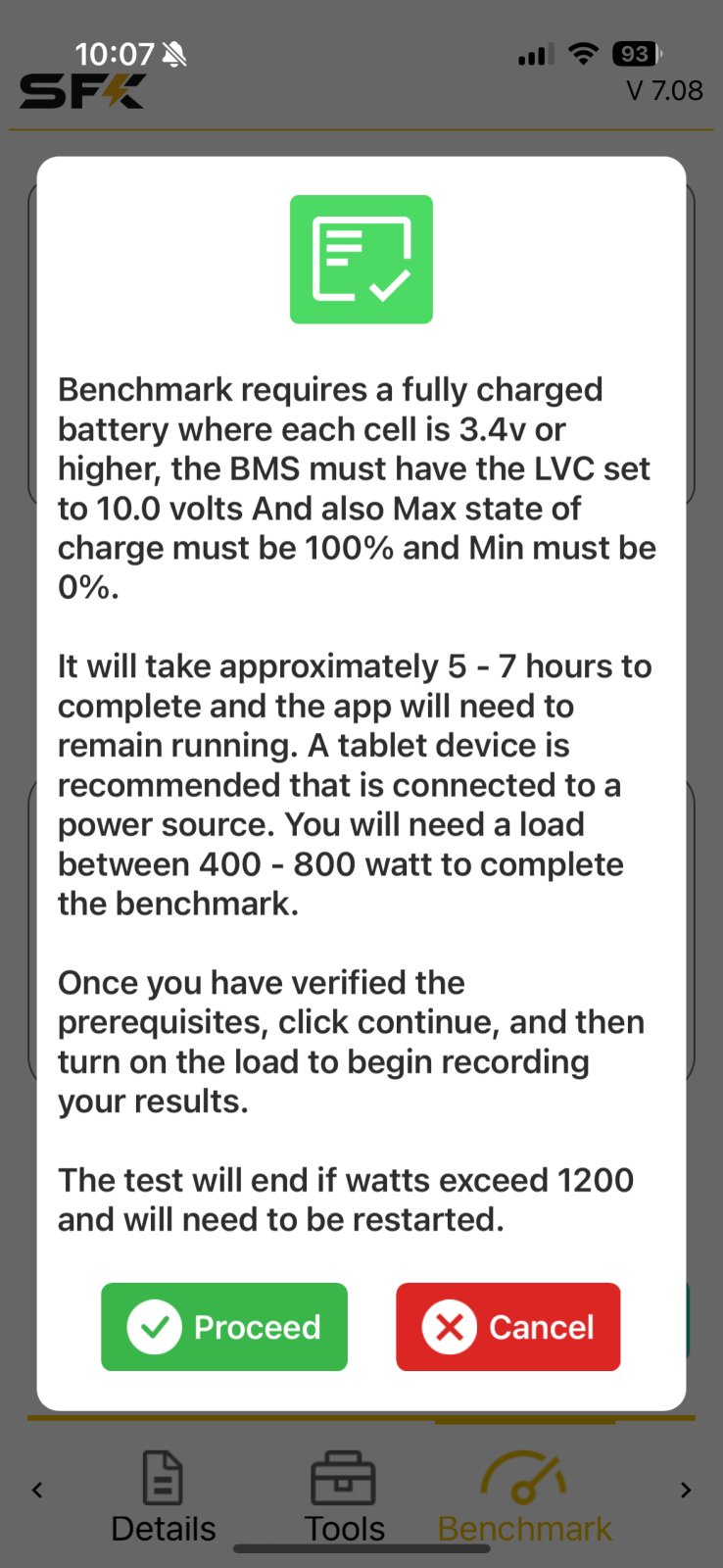
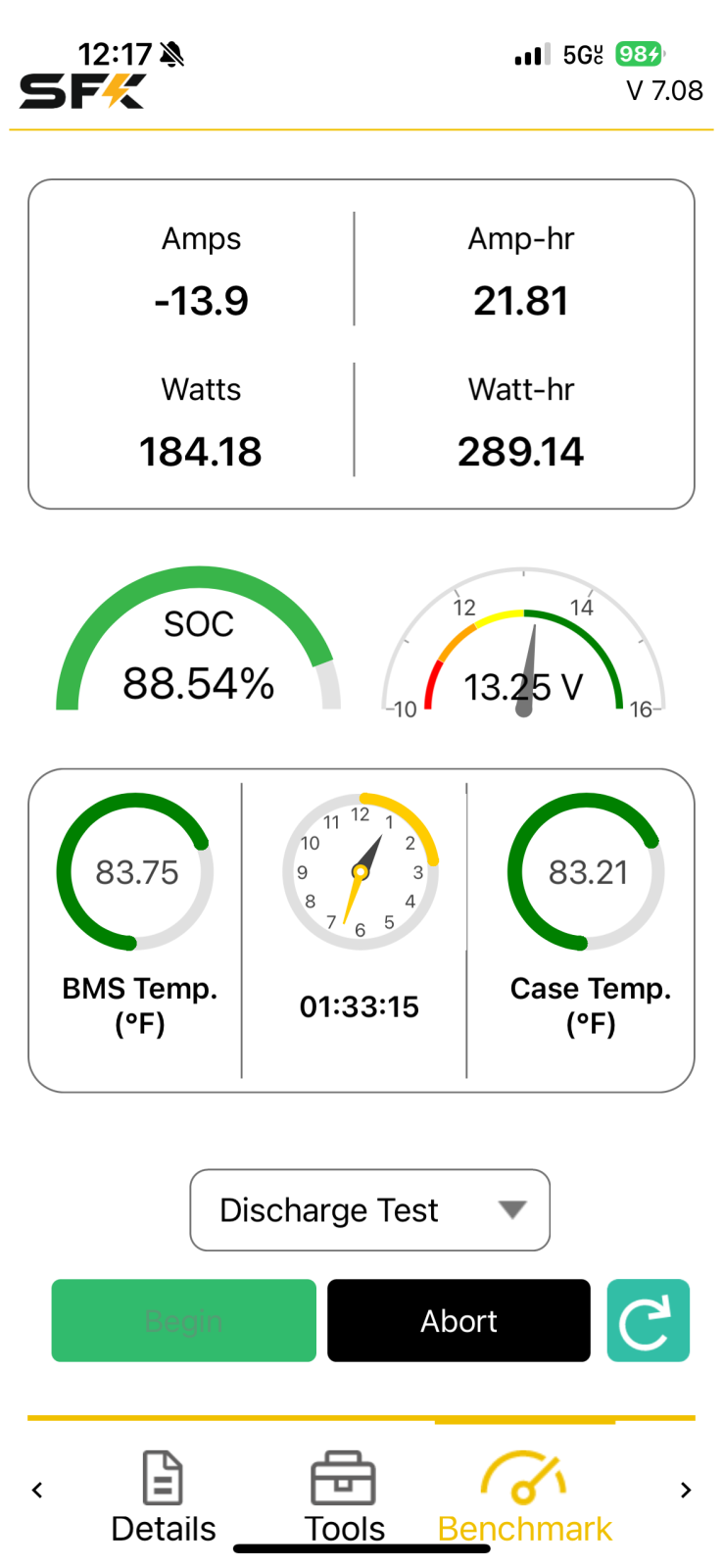
In another first for me, the SFK app includes the ability to record tests of both charge and discharge cycles to measure the capacity and performance of the battery. To performa a full test, you will probably need a tablet or phone you can leave plugged in and next to the battery. The screenshots above were taken while I was performing a 20 hour capacity test, so my load isn’t in range for what SFK requests and a full test would take 20 hours.
Victron communications
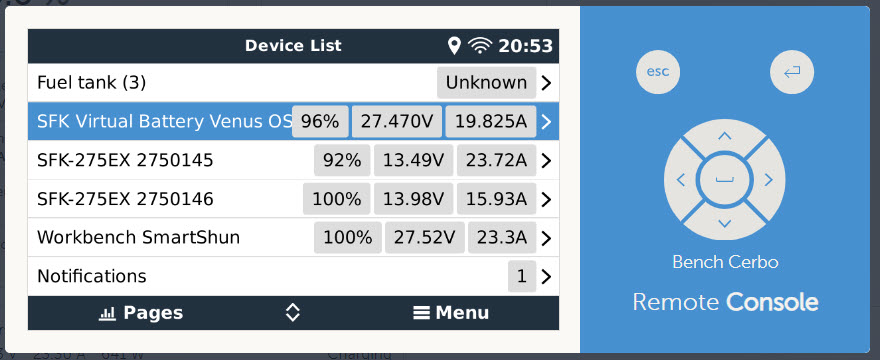
SFK has taken a different approach to delivering communications between their batteries and Victron’s Venus operating system and GX hardware. Other batteries I’ve reviewed and worked with have relied upon CANBus communications via either VE.CAN or BMS.CAN.
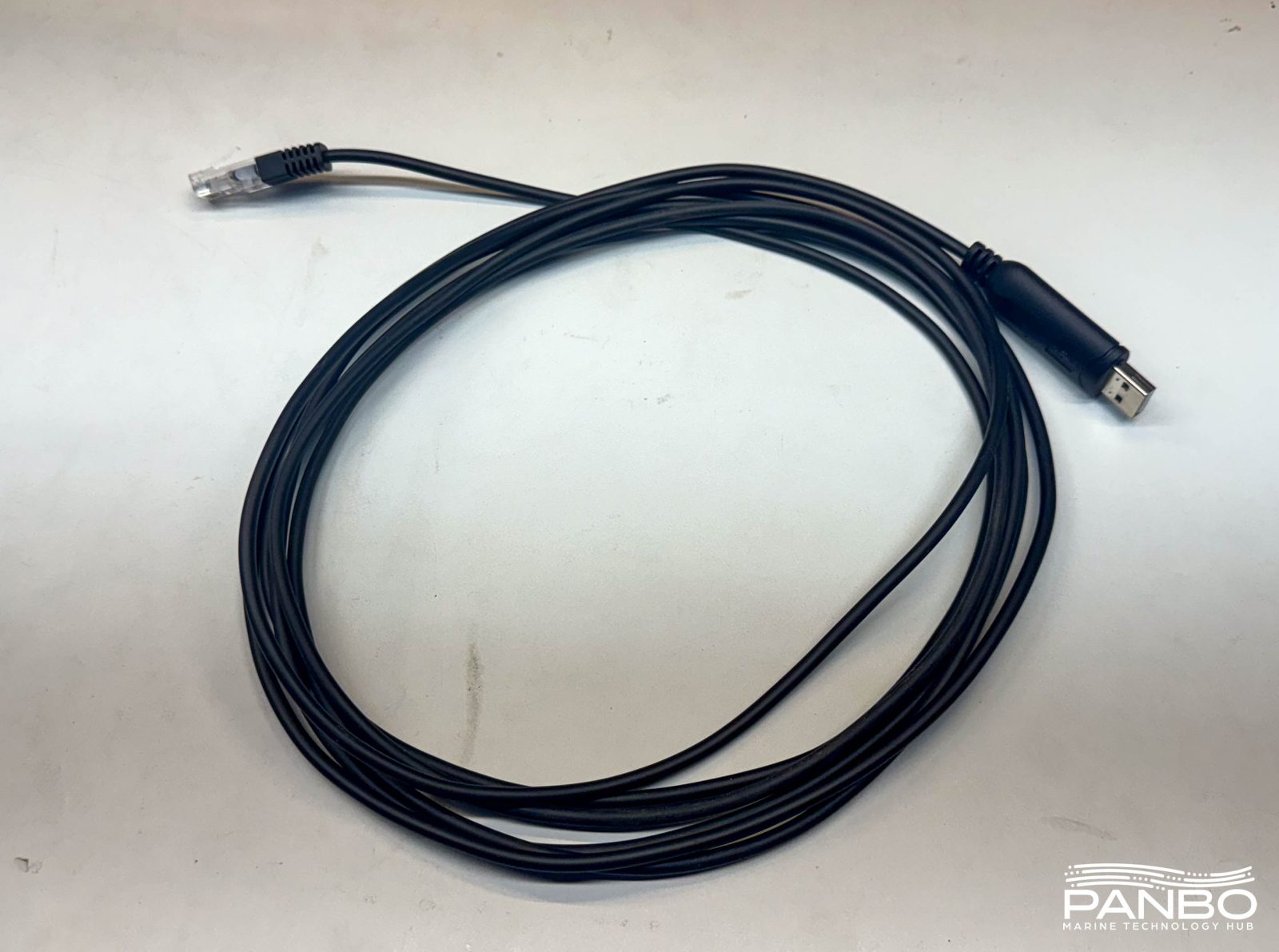
SFK relies on an RS.485 output from their batteries and an RS.485 to USB converter built into an interface cable. SFK’s reasoning for this approach is greater control of the Venus to battery interactions when connected via virtual terminals, rather than Victron’s CANBus mechanisms. The cables are available with an RJ-45 connector suitable for dry locations as well as a waterproof option.
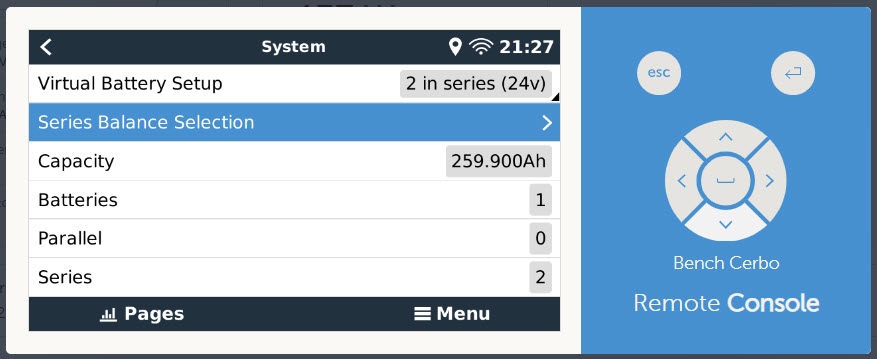
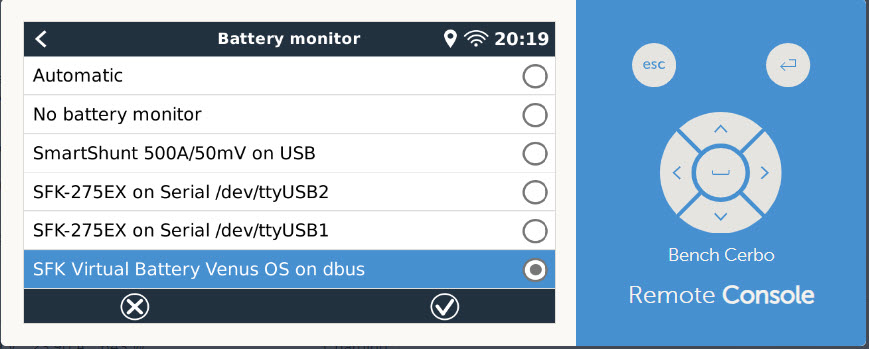

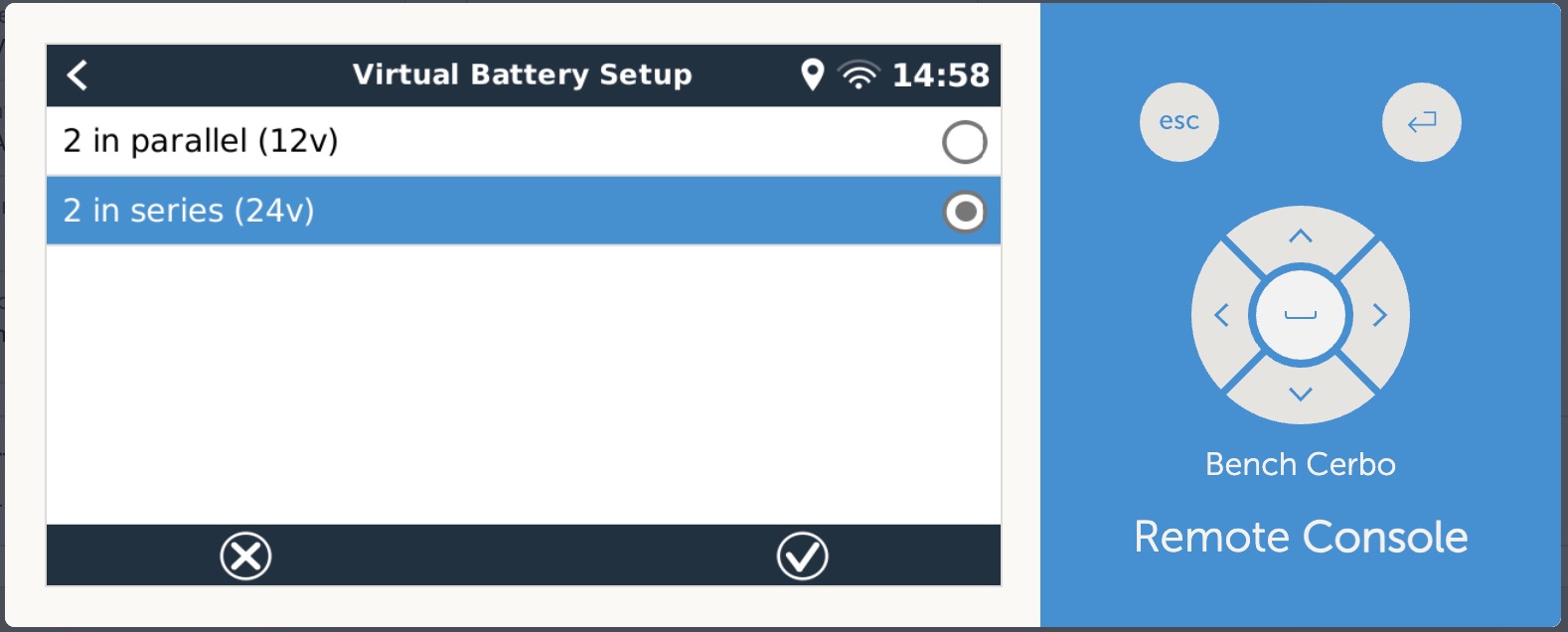
Once the batteries are connected, and note that with only two active USB ports on most Cerbos, you will probably need a USB hub, your batteries will appear as devices just like a CANBus connected battery. The SFK batteries can be selected as the primary battery monitor via the GX’s system configuration. The batteries work with DVCC and generally behave as you would expect a connected battery to behave.
Once you have connected multiple batteries, you can define a virtual battery. As shown above, a configuration dialog is displayed giving the option to configure your batteries in parallel or series. In my setup, once I defined the virtual battery, I selected it as the primary battery monitor for the GX’s and VRM’s visualizations. By playing with SOC and current limits, I was able to watch the battery update charge rate and finally fully block charging from the configuration changes I made in the battery’s app. It’s safe to say this is the most complete Victron integration I’ve seen this side of Victron branded batteries.
Series balancing

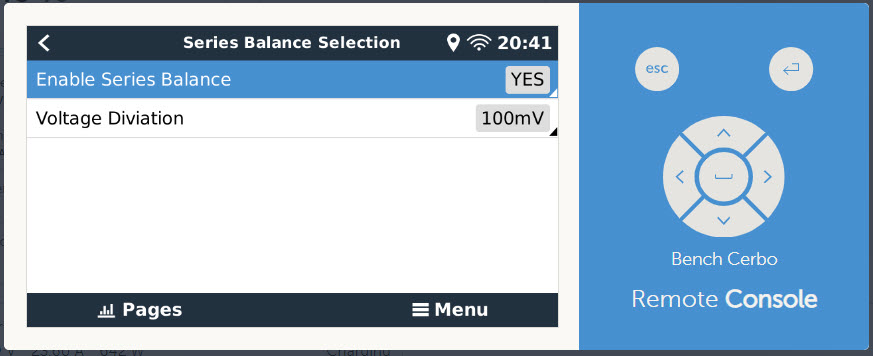
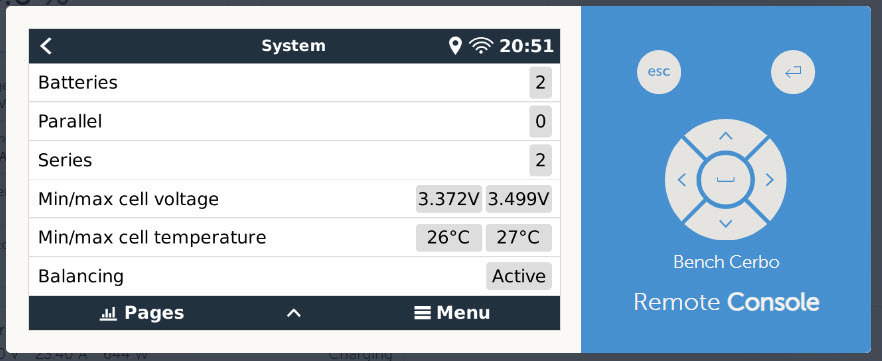
Internal BMS batteries wired in series typically don’t have any way to manage balance between the batteries. Without such a mechanism, the only balancing option is to break the series link and apply individual 12-volt charge to bring each battery to the same state of charge. SFK has a clever solution to this problem. By leveraging the battery’s heating pads, they can place a load on the highest voltage battery to reduce its charge acceptance and allow the laggard to catch up.
I am currently testing relatively early beta software to demonstrate the functionality. In my testing the functionality worked well, though it appeared a little bit slow to respond. SFK is pulsing the heater on and off to avoid introducing too much heat. They also will add clearer visualizations of the battery temperature to the console and tight protection of the battery temperature when using the functionality.
Tear down
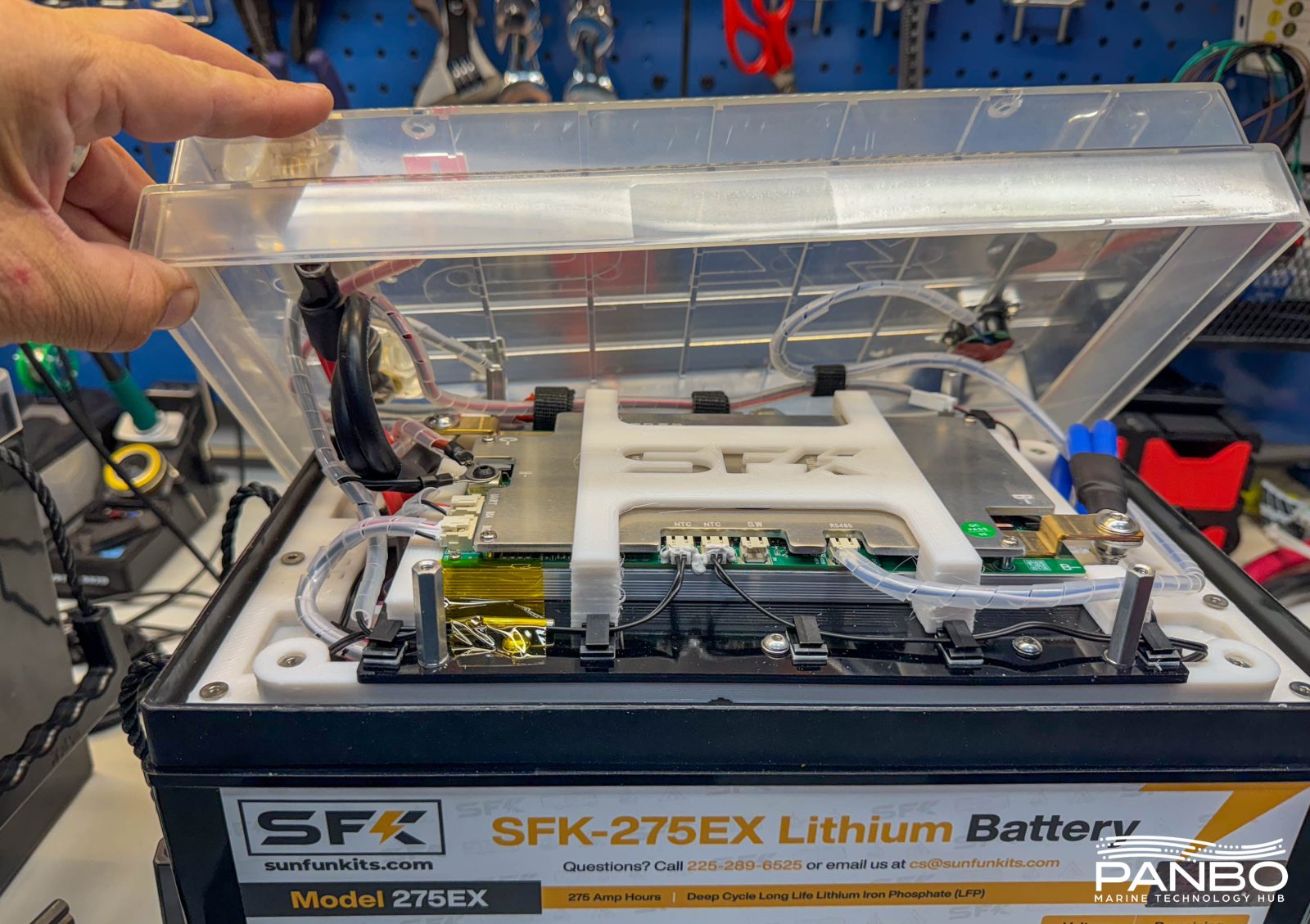
Although the clear lid provides a sneak peak inside, no review would be complete without a tear down of the battery. SFK prides themselves on the battery’s serviceability so I wasn’t expecting this one to be difficult. Those expectations were rewarded with an easy disassembly. The lid comes off with four hex head screws. From there it was just a question of breaking the tension of the impressively tight physical fit of the lid to the case.
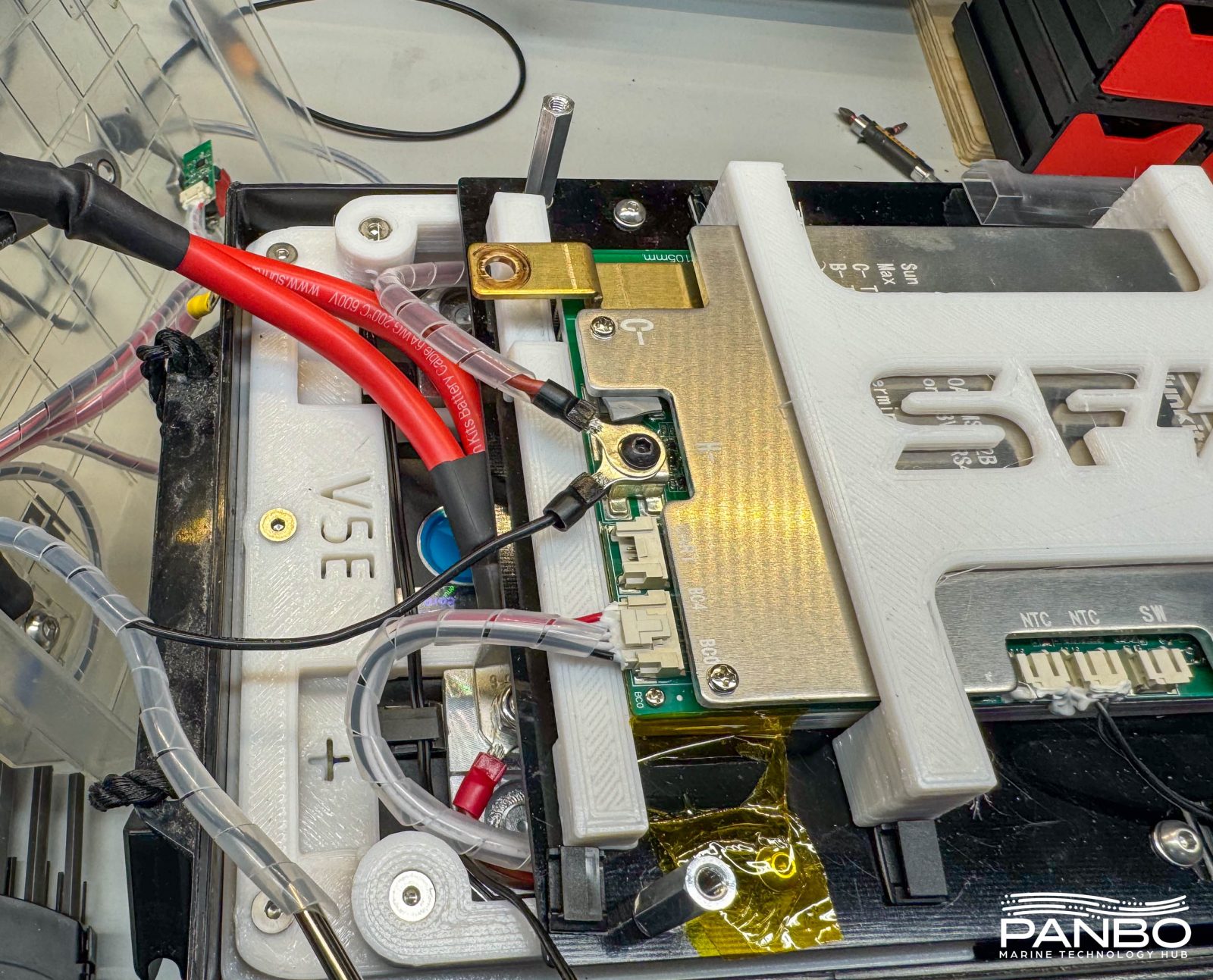
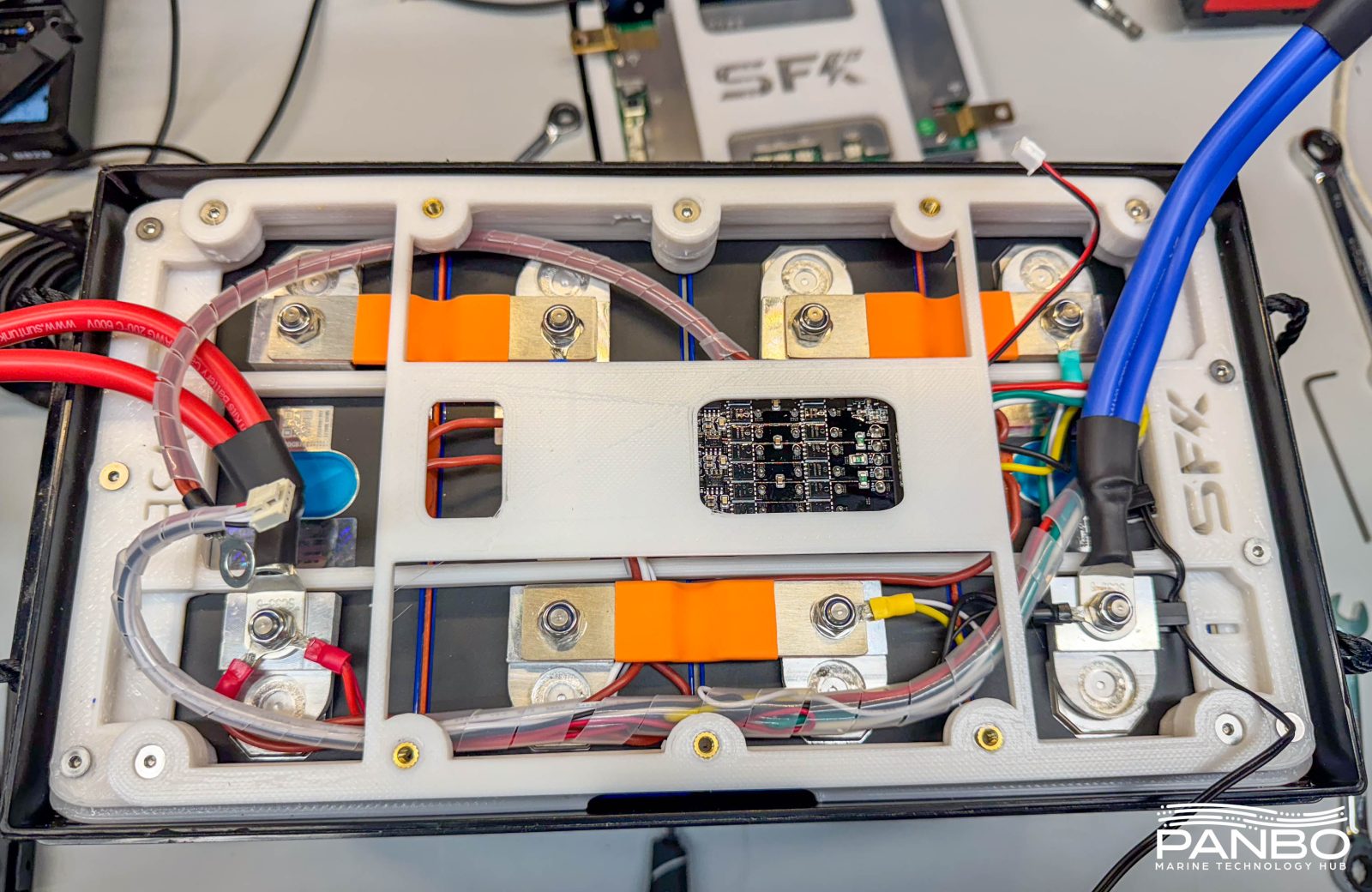
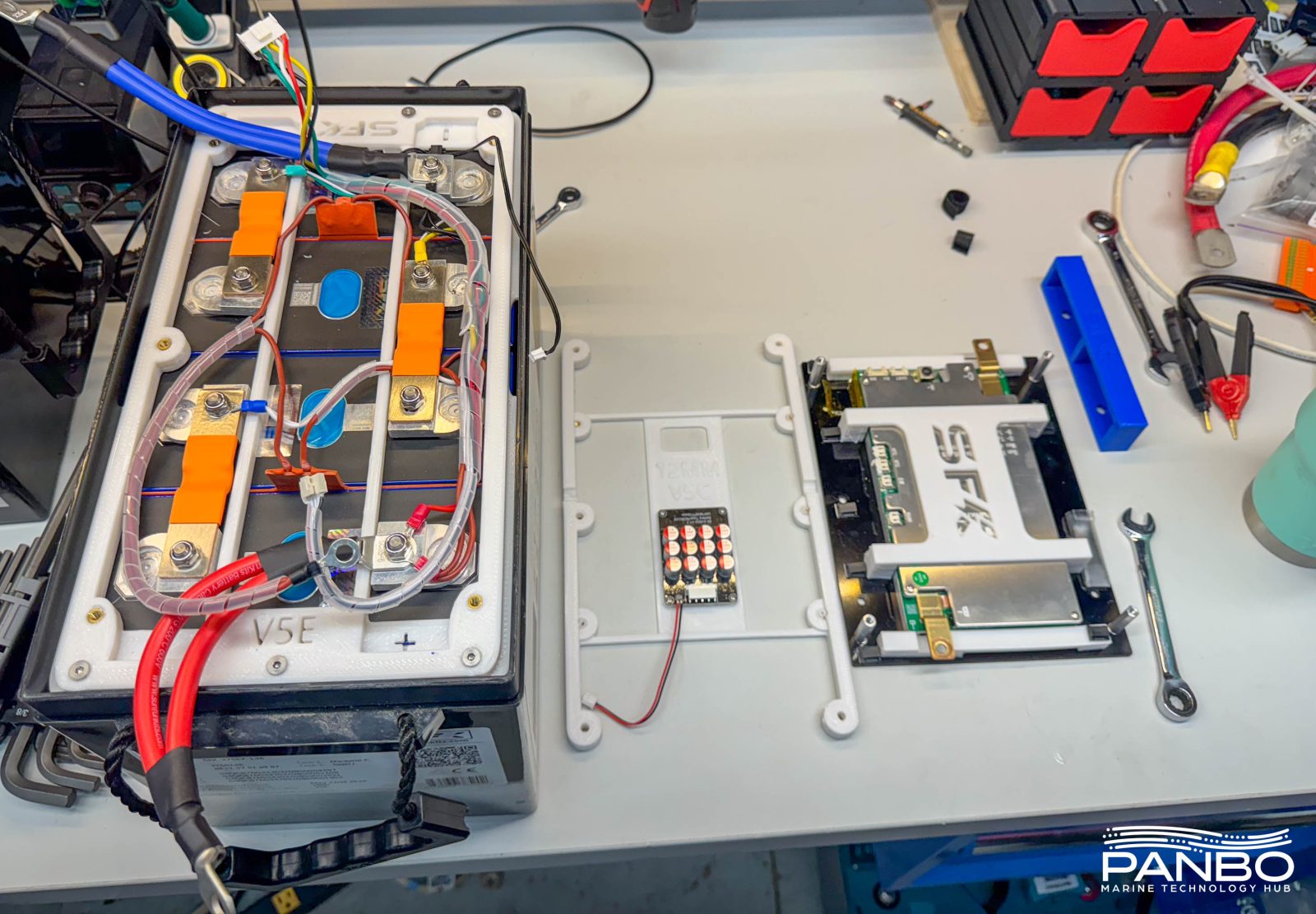
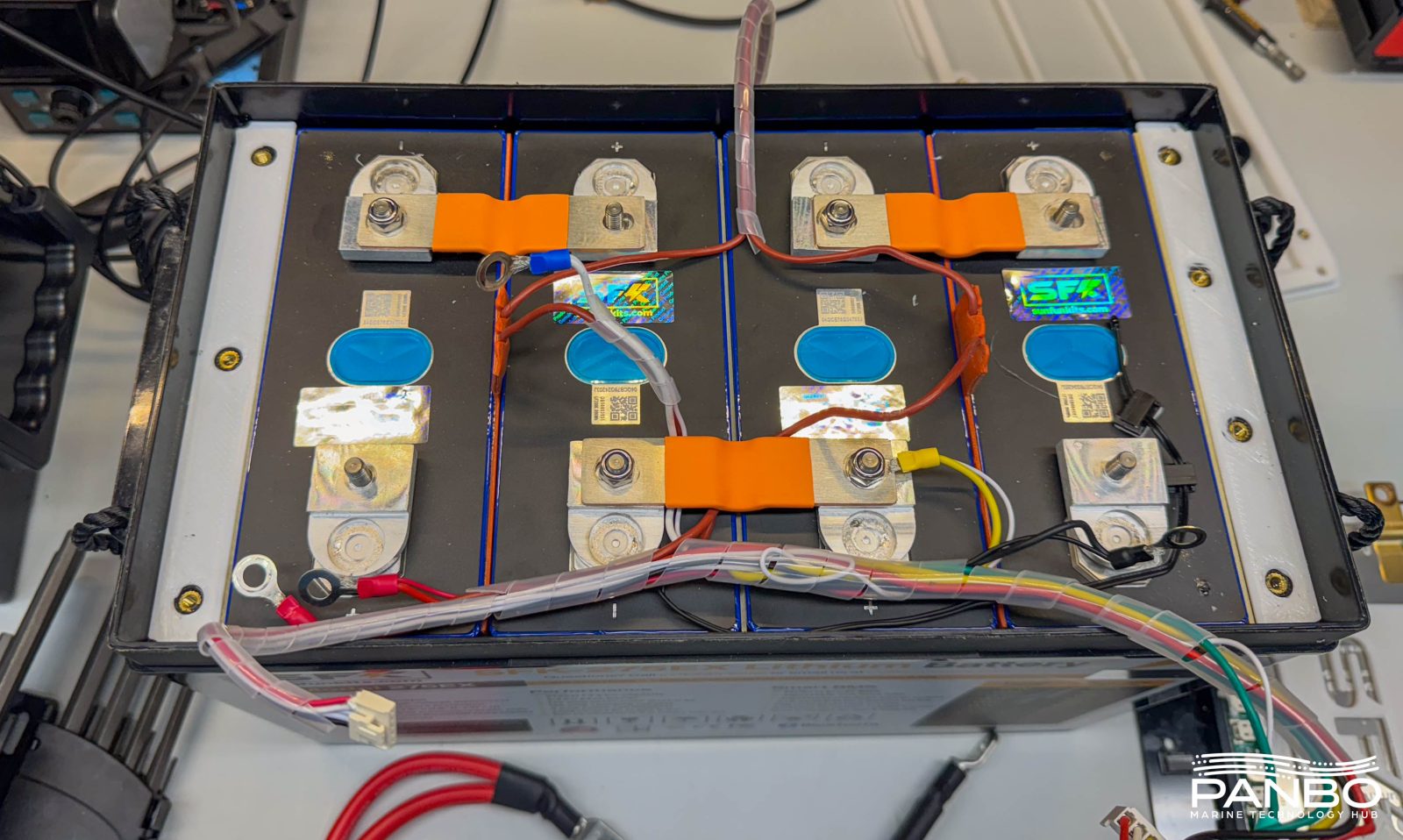
With the top tipped up, temperature, balancer, button control, heater, and pack connections all had to be removed to separate the top from the case. Now that the top is removed, a few more screws also removes the BMS and its G10 and 3d printed carrier. Removing the BMS revealed the active balancer mounted to another 3D printed carrier. Removing the balancer gives access to the top of the cells. Here I found laser welded thread adapters, intact battery QR codes (that matched the data from the battery information sticker), and flexible tinned copper bus bars.
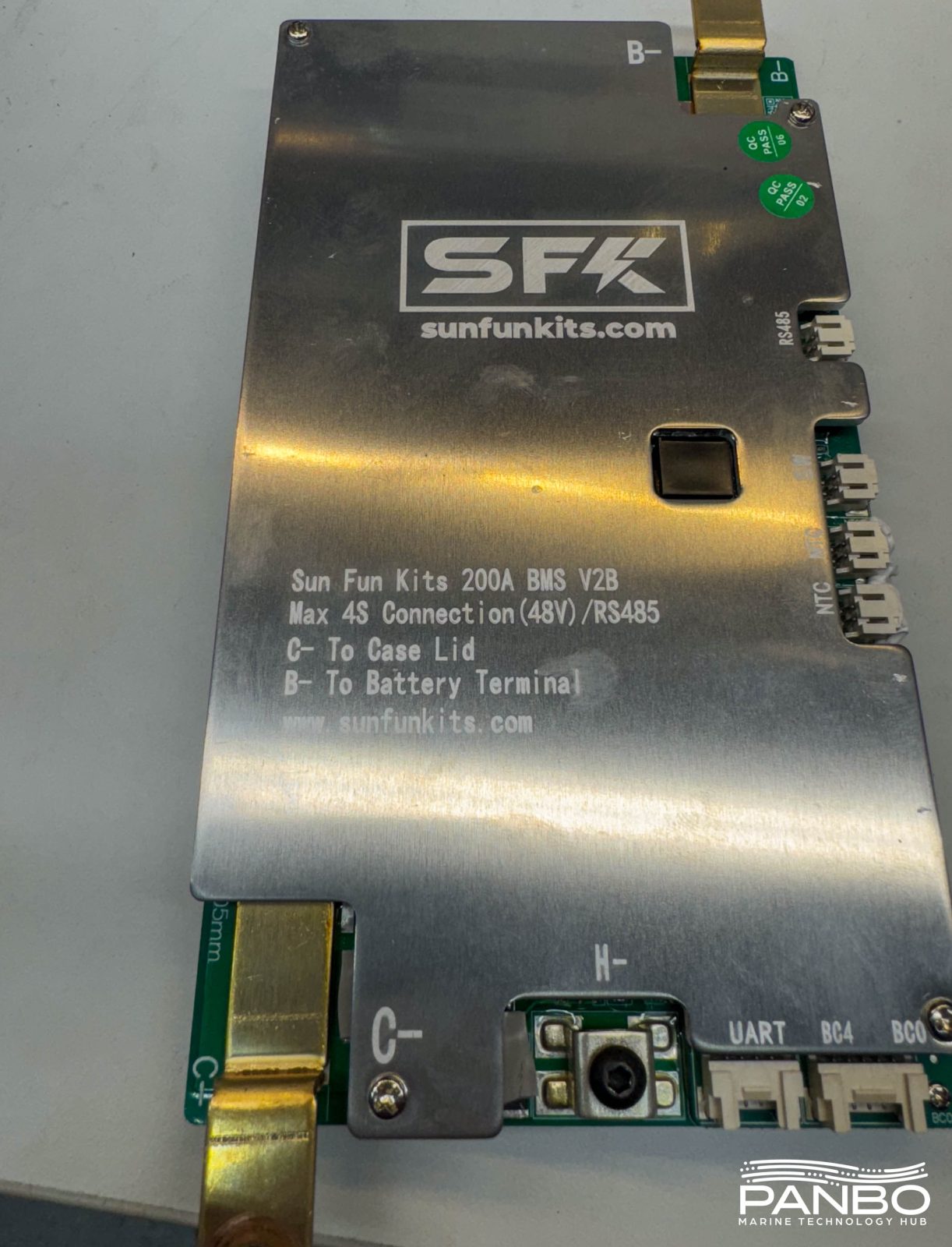
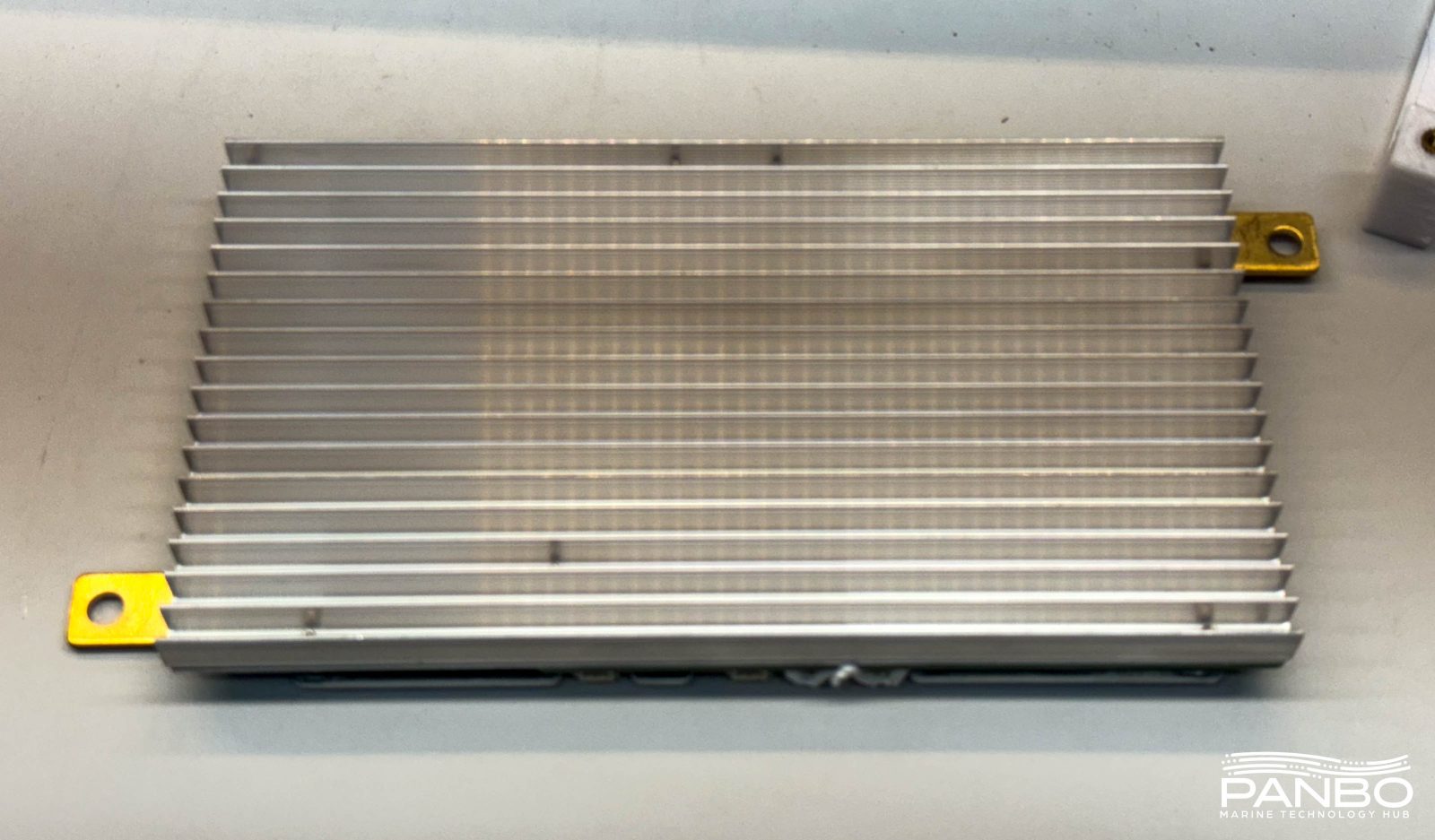
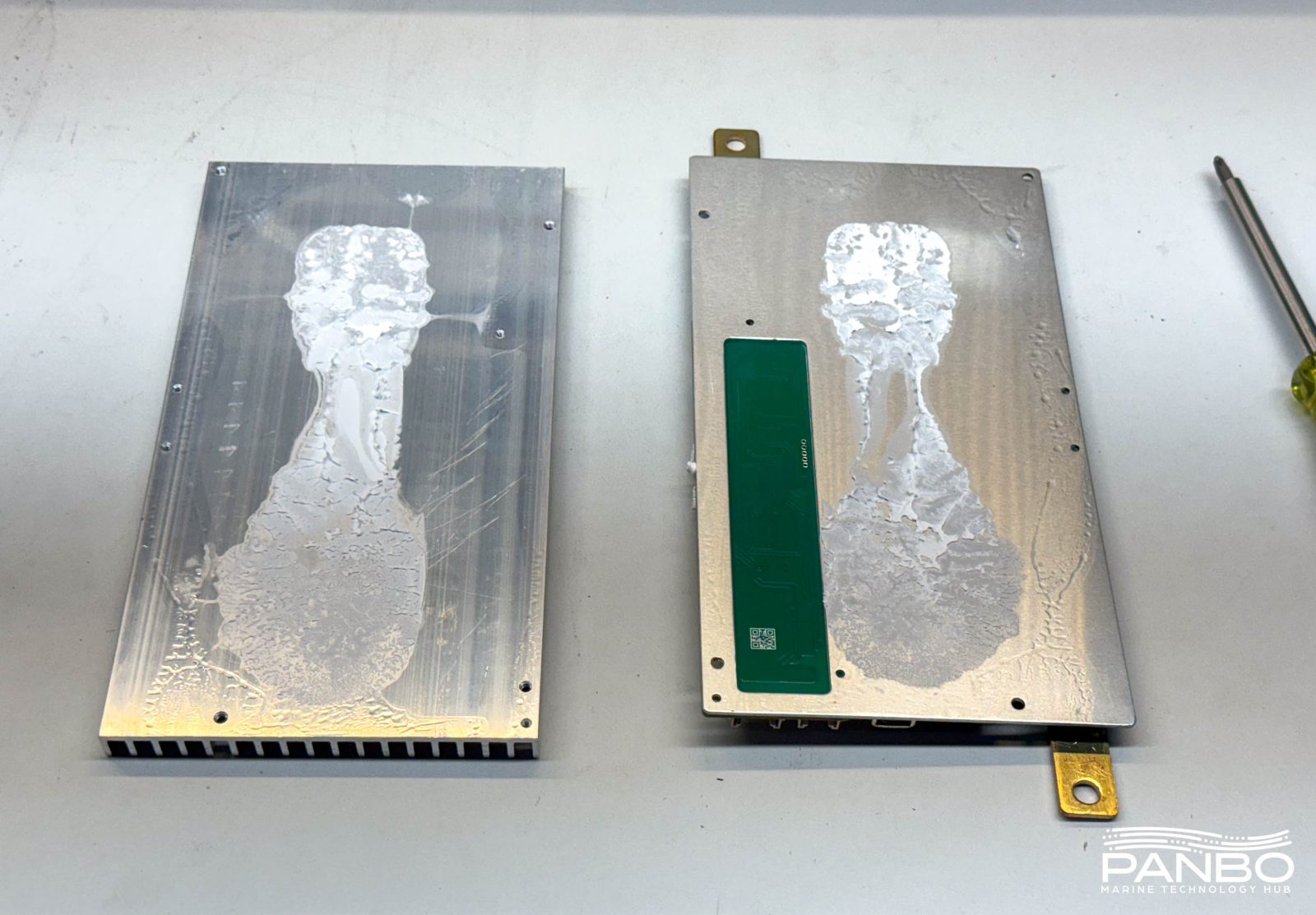
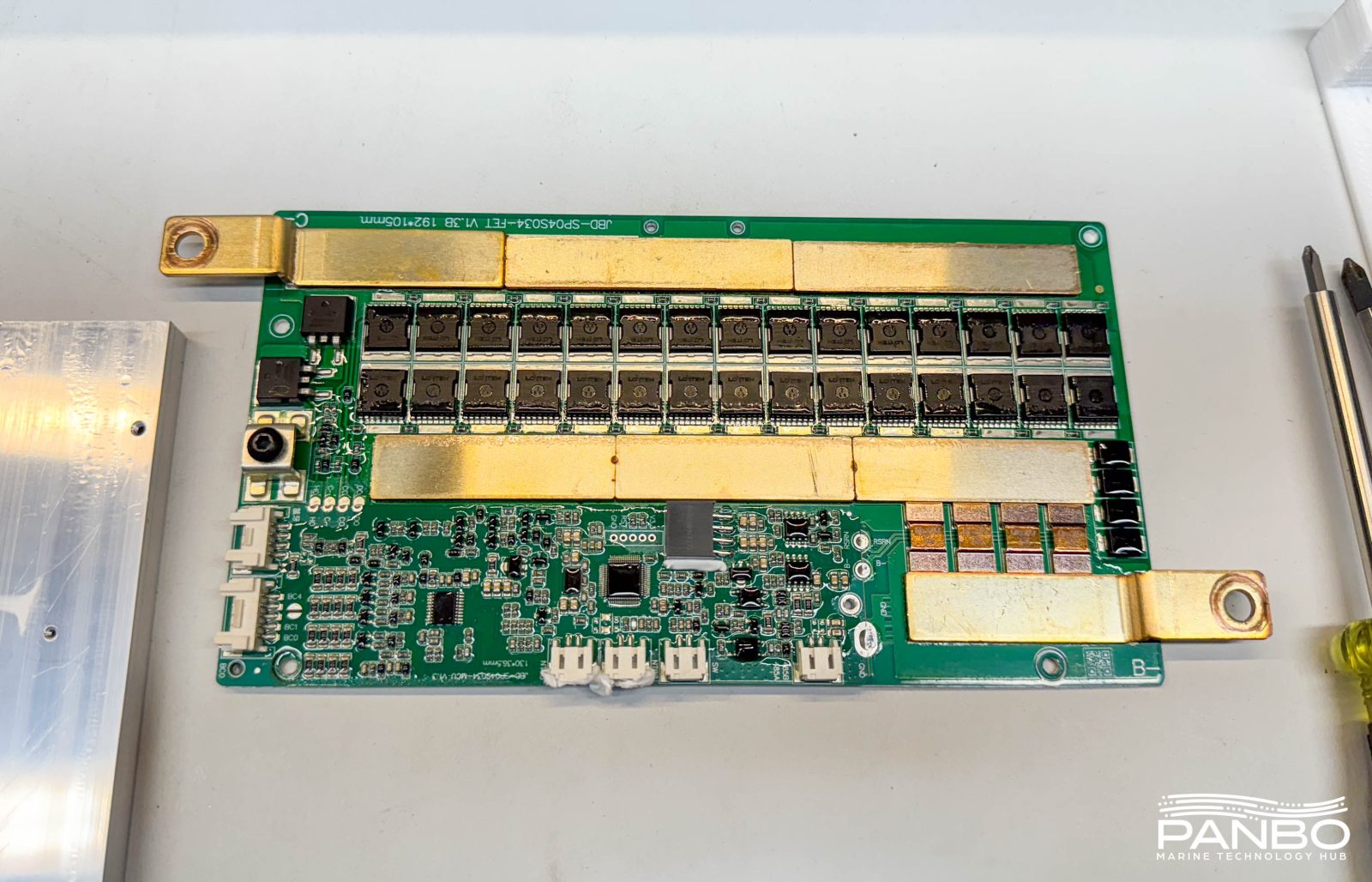
The BMS is physically very similar to a JBD BMS. SFK tells me they are made by the same manufacturer as JBD, but some of the components are different. I don’t have a reference matching JBD on hand to compare. But, there’s no doubt the SFK BMS is running a bunch of custom firmware to deliver the functionality we’ve seen above. SFK also fits the BMS with beefy heat sinks to aid heat dissipation.
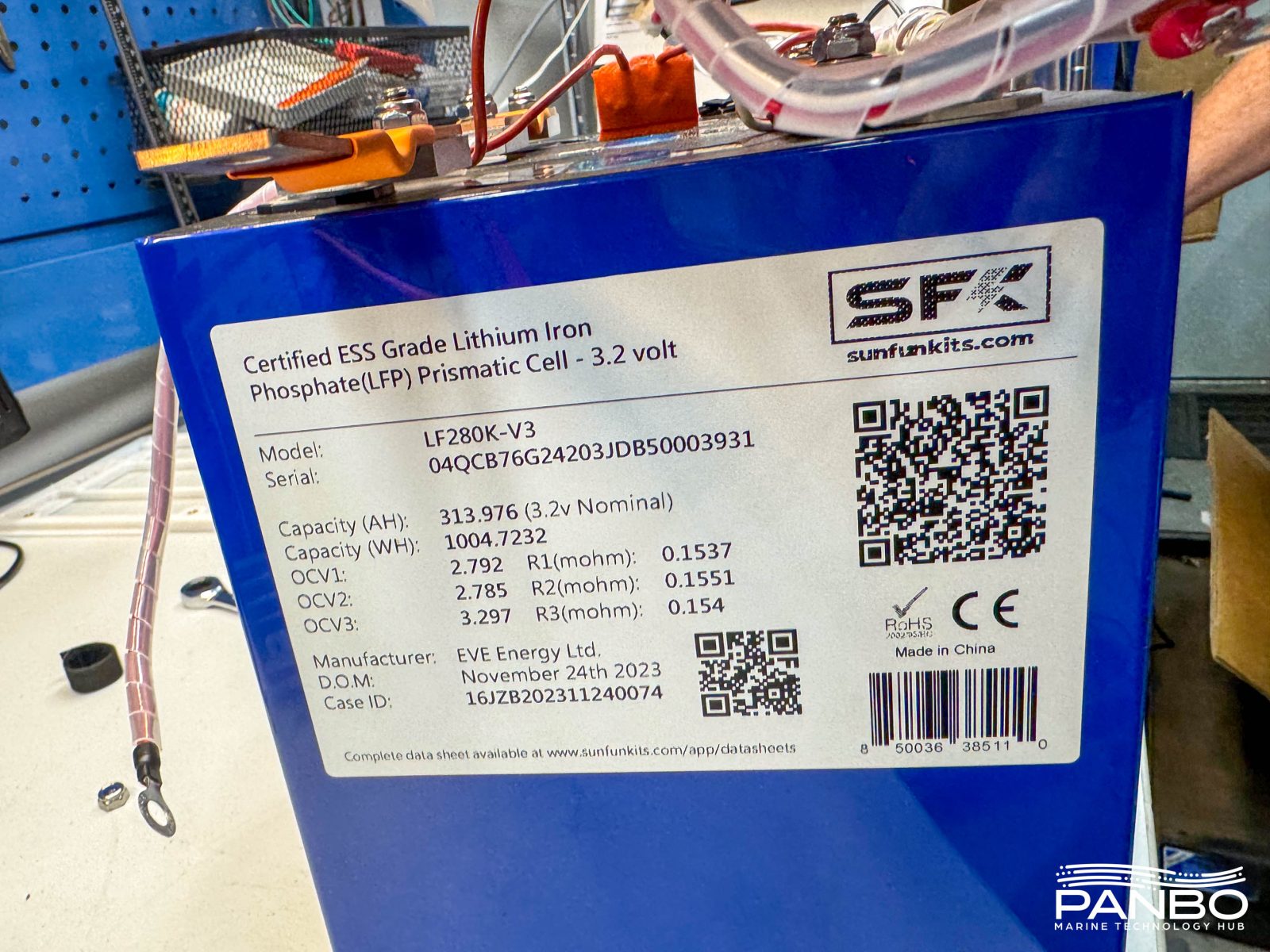
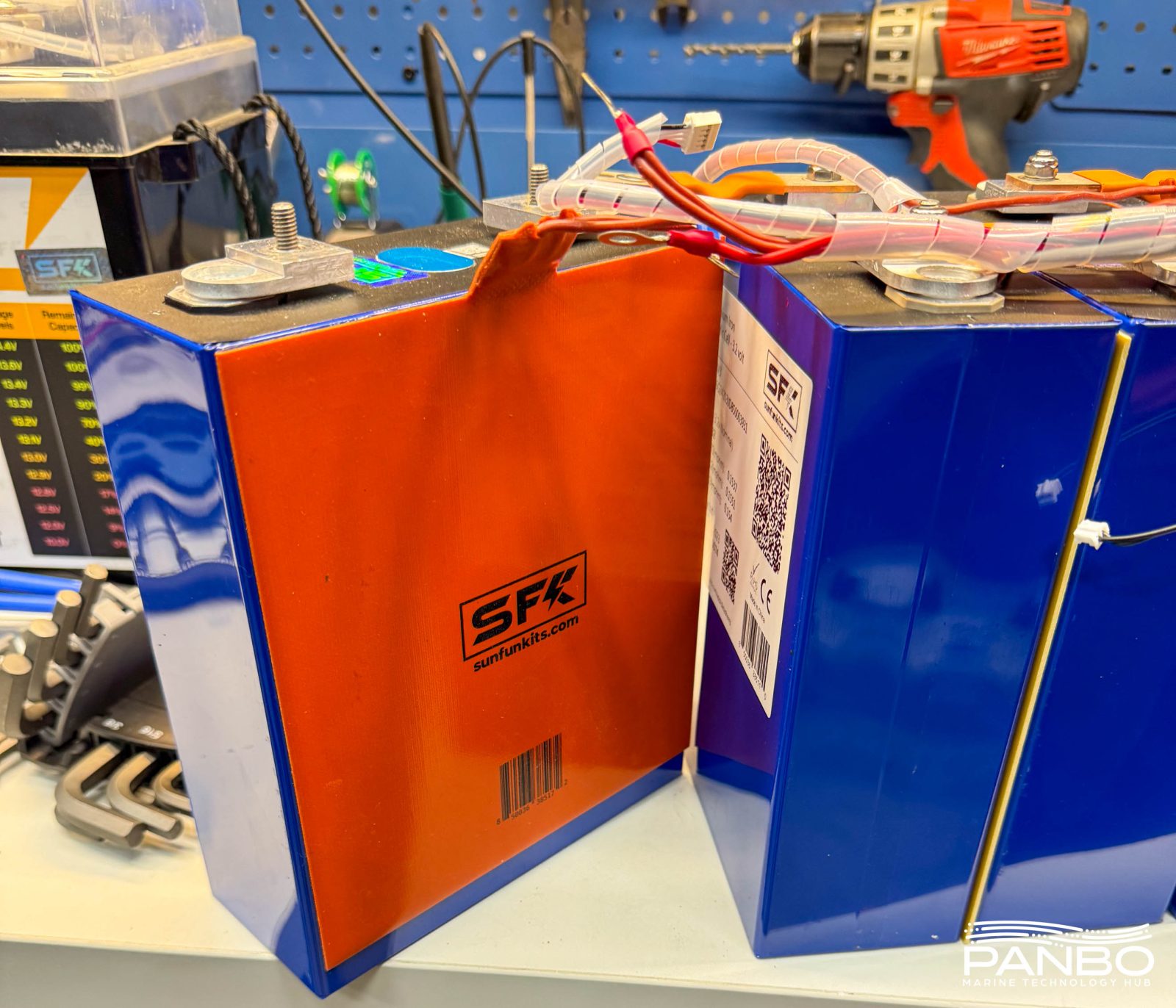
Last up is an inspection of the cells and heating pads. Here I found each cell has a sticker matching the information we found from the battery data sticker on the outside of the case. Additionally, it’s worth noting the use of two heating pads sandwiched between each pair of cells. This seems likely to be a more effective way to propagate heat through the cells than attaching to one side of the four cell pack.
About the only thing I didn’t find during my disassembly were temperature sensors on the external terminals. This detail we’ve seen on quite a few Epoch batteries is a great safety measure and one I hope more battery makers will adopt.
Final thoughts
Based on the feature set, form factor, build quality, and documentation there is a lot to like about these batteries. SFK isn’t (yet) a household name and I don’t think they’re building these batteries in huge quantities either. Because the batteries are hand assembled in Louisiana, there is some question about how well they would be able to scale up. But, based on what I’ve seen, I think they have earned the opportunity to show what they can do with greater demand.





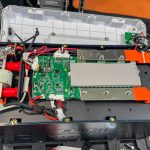







Did you have any voltage cut-off at 13.8 issues with these batteries? Is it like the epoch 460 that raises alarms? Also what were your capacity test results?
Salman,
No issues with voltage cut offs over 14 volts. I also verified the BMS parameters show no such behavior. It is the charge MOSFETs opening in the Epoch 460 that cause the alarms. These batteries don’t have that behavior and hence I haven’t seen any alarms.
I just updated the article with my final capacity test after using the batteries for the summer. With about 35 cycles on the batteries, I got 298.2 amp hours on a 20 hour capacity test.
-Ben S.
Those seem pretty darn amazing. I love the BMS adjustability as well as the virtual battery option. I thought I read somewhere that they had the ATC and ATD signals that may help or work with external alternator regulators? I see they have been around a couple of years..I am surprised they aren’t more popular. Great article Ben.
I have 2x of the 300HP in my Class C RV and they are the best batteries on the market. I’m using them with a Cerbo-S and I talked with Austin before buying my setup (I told them they should be a victron dealer as he knows more about victron than anyone else I spoke with). My setup is the multiplus 2 3000, Smart Solar MPPT 100|30, 2x 300Hp batteries and there cables) and I have them inside there insulated bags, I’m surprised they didn’t send these to you, they are great).
What I love about these batteries is you can choose how the heating works, you can simply go to the app and choose standby and it just makes sure the battery is at least 5 degrees Celcius so it won’t freeze, I looked at the epoch but there heating only works if you try to charge it in the cold not if its just idle…). I keep my rv plugged in and I set the upper SOC to 80% so they don’t stay full. So now my batteries won’t freeze and they won’t be stressed.
The integration has also been perfect no issues at all, in fact I believe this is better than victron’s own batteries because they have external BMS and you can’t throttle the amps like you can on the SFK.
I replaced 3 battle born 100s with these and its easily the best purchase I have made all year. I’m happy more people are finding out about them. There is truly nothing on the market that comes close: The software, the support, the expertise, un matched, the guy will literally spend 2 hours on the phone with you and I can talk a lot! I will say its a bargain for what you get, they ship these free to Canada!
Matthew,
Funny you should mention heating. It’s the one feature that I didn’t cover (and probably should have). This review was already very long and I was hesitant to make it even longer. That said, you’re absolutely right that the heating functionality in these batteries is unique. The ability to control the heater behavior allows things you can’t accompolish with other batteries.
Also, SFK did provide the blanket bags but I haven’t used them. It’s a bit toasty here in Florida and keeping heat in hasn’t been a concern.
I think they’re great batteries, though I do wish they supported multiple parallel strings of series connected batteries.
-Ben S.
Howdy Ben,
Dwayne here (Owner SFK), the driver currently supports up to 8 batteries, you can hook them up as multiple strings so e.g. You can have 2s4P where you have 4 pairs of 2s (2 in series) the virtual battery driver will have this appear as 1 big giant 24v battery so it will show the option as 24v 1100 AH. Other options with 8 batteries could be: 4s2P 2 pairs of 4s (4 in series), this would appear as 48v 550 AH. Lastly you could have 8P where it can appear as 12v 2200 AH. The driver will change available options based on how many battery it detects.
You will need 2x 4 port usb hubs for this and each connected to one of the Cerbo GX data ports.
We have a few customers running these jumbo setups such 24v 1100 AH setup or 12v 2200 AH.
You can email Ahsan if you need more info about these jumbo setups.
Currently we don’t yet support separate banks in the driver, but this could be added too as well where you have multiple virtual batteries; if the demand is there it could also be added.
Thanks
Dwayne,
That’s great news. I was under the (mistaken) impression you guys weren’t supporting such configs. I appreciate the correction.
Ahsan has been great in helping me get this review together. At this point, he’s probably tired of hearing from me.
-Ben S.
No problem, the driver also supports 5p, 6p, 2s3P, 3s2p, 7p and other configs. We found after 8 batteries the cerbo started to get sluggish so maybe we are pushing the device too hard with this many batteries; we may need to lower the poll rate down to 3 seconds or maybe 4 (this means data would refresh less often) to support more than 8, you will also more than likely need a powered USB hub after 8 devices.
Thanks again.
Dear Ben,
I think you need to have a head to head between this battery and the epoch 460. I have been eyeing this for a while and Jasonoid did a review of them but wasn’t able to test the victron functionality, judging from what you have found do you think the Victron Communication is stable and it would play nice with DVCC?
In terms of construction the epcoh seems to be at a whole different level but the SFK seems decent and serviceable and I like that you can take out the cells.
After also reading your epoch 460 review, what would you pick if you had to choose between the sfk 275 or the epoch 460 if you wanted communications. The 275 EX are right now $1115.00 and have free shipping and they aren’t charging sales tax to North Carolina. The epoch 460 is about $2098 after taxes and shipping vs $2230.00 for 2x of the 275EX batteries but also 550 AH for an additional $130.00?
This may change if Sun Fun Kits start charging sales taxes in my area or got rid of free shipping, but one of the things I see no one is talking about is the shipping prices of the Epcoh they are quite high vs many other places that give free shipping.
btw there is a quite a big thread on sprinter forums regarding this and a few people have gotten the 300HP battery they seem to be happy with it.
Kevin,
I’ve tested comms and DVCC with both batteries. If Victron communications are a priority for you, I think the SFK implementation is superior. With the 460, Victron Comms become a nuisance if you trip the battery’s full charge protection mode. No such challenges with SFK.
If anything, I think the more competitive comparison is between these batteries and the Epoch 300ah dual purpose batteries. Those also have Victron comms and don’t have the full charge protection behavior.
-Ben S.
Great, I’ll be watching for the review of the 300AH dual purpose epoch, I wasn’t aware epoch had a 300AH with victron communication, checking them out now. In the mean time I’ll be saving my pennies waiting for a black firday sale haha.
Seems like an excellent battery for the price! Assembled stateside is a plus.
I have been buying SFK kits since 2022 and also have about 130 cells form them. Its nice to see they have pre-built batteries, but you can build the same as a kit and save about $200.0/battery which makes these even cheaper than LiTime and Chins stuff.
I referred my neighbor to them, he was driving his Newmar Rv from Arkansas to Florida, picked up the batteries at SFK on the way there, the owner told them if he didn’t like them during is trip on the way back he can return them and get a full refund. That’s service.
One last thing I told them they should drop the whole Sun Fun Kits gag and just called them SFK and It seems I’m not the only one because many people seem to not know they have assembled batteries.
Does wakespeed integration happen via the Victron comms?
If you are using a cerbo then you connect the wakespeed to the cerbo this will then allow communication between the battery, the cerbo and wakespeed.
If you are not using a cerbo, then the sfk hub (check our blog) will eventually have the RV-C protocol support which will allow communications between the batteries and the wakespeed without the need for a cerbo
I got my batteries on Friday and setup the cerbo-S GX with the driver so far they are running very nicely, it was very simple to setup them in parallel with the virtual battery. I am using 2 of the 275EX and multiplus II 3000 12v inverter. Thanks for the detailed review it really helped my decision to go with sfk.